38+ Different Types Of Moths (With Names And Pictures)
Moths, often considered pests in many parts of the world, are more than just the winged creatures that flutter around our screens or doors during hot summer nights. In fact, some species of moths are actually good pollinators! Moreover, they come in a stunning array of shapes, colors, and sizes, making them fascinating creatures to learn about. If you’re interested in understanding the life cycle of moths, knowing the different types is a great place to start.
This article will delve into the world of moths, exploring their symbolism, what it means when they land on us, how they compare to butterflies, and most importantly, providing an extensive list of moth species. From the Atlas moth to the Yucca moth, we’ll cover 38 different types of moths, each with its unique characteristics. So, let’s take flight into the wonderful world of moths!
What is a moth?
Moths, belonging to the family Lepidoptera, share a common thread with their famous cousins – butterflies and skippers. With over 16,000 species, moths are characterized by their nocturnal flight patterns. Interestingly, these insects thrive in tropical to subtropical climates only. The largest moth species are often brown in color, with a unique trait: dust-like particles on their bodies.
On average, they sport a wingspan that ranges from 4 to 30 millimeters, showcasing the remarkable diversity within this group.
Moth symbolism
Across cultures, the moth embodies a multifaceted symbolism that can be both empowering and ominous. One interpretation is that its innate attraction to light or flame represents the relentless pursuit of positive change or transformation, often requiring great effort and determination. However, this same trait can also signify reckless abandon, as seen in Navaho culture where being drawn to the light may indicate a state of madness or foolishness.
In many Native American and European tribes, moths are used as sacred rattles to invoke the spirits of ancestors, seeking guidance and good fortune. Meanwhile, in certain regions, the moth has become synonymous with mortality, a concept popularized by the iconic film Silence of the Lambs. Ultimately, the moth’s symbolism serves as a poignant reminder of the dualities that exist within human nature.
What does it mean when a moth lands on you?
When a moth lands on you, the significance can be multifaceted, with color playing a crucial role in deciphering its meaning. One of the most intriguing interpretations is tied to the shade of the moth. For instance, if a white moth makes contact, it’s believed that the spirit of an ancestor is present, either seeking guidance or offering a warning. In contrast, black moths are often seen as harbingers of negative energy, potentially foreshadowing evil or death.
On the other hand, brown moths may indicate the need for heightened vigilance or careful consideration when selecting who to surround yourself with.
Moth vs butterfly
While both butterflies and moths belong to the Lepidoptera family, they exhibit distinct physical and behavioral characteristics. One notable difference is their activity patterns: butterflies are diurnal, meaning they’re active during the day, whereas moths are nocturnal, earning them the nickname ‘night fliers.’ Butterflies typically curl up their wings when at rest, in contrast to moths, which assume a flat, wing-splayed position.
The pupal stage also shows significant variations: butterflies emerge from silkless chrysalises, while moths are wrapped in silky cocoons. Moreover, moths tend to be more stout and possess duller, less vibrant colors compared to their butterfly counterparts.
Moth identification
With over 160,000 recorded moth species worldwide, it’s no wonder that a significant proportion can be found in various regions. In the UK alone, around 2,500 species have been identified, while in the US, approximately 11,000 species call this continent home. The remaining species are dispersed across parts of Asia, Africa, and Europe. To effectively identify moths, it’s essential to consider several key characteristics.
Firstly, moths are nocturnal, which sets them apart from their diurnal counterparts – butterflies. In terms of physical attributes, moths tend to have a more robust body shape compared to butterflies. Additionally, some moths exhibit specific habits, such as nesting on fabric, wool, or in high-humidity environments. Interestingly, while many moths do not drink nectar like butterflies, some species still engage in similar feeding behaviors.
Furthermore, moths are characterized by the release of fine particles from their legs, which can be an important distinguishing feature. Another key characteristic is the absence of antennae, a trait that distinguishes moths from butterflies. For those looking to hone their moth identification skills, online tools such as Discover Life provide valuable resources for this endeavor.
Types of moths
Atlas moth (Attacus atlas)
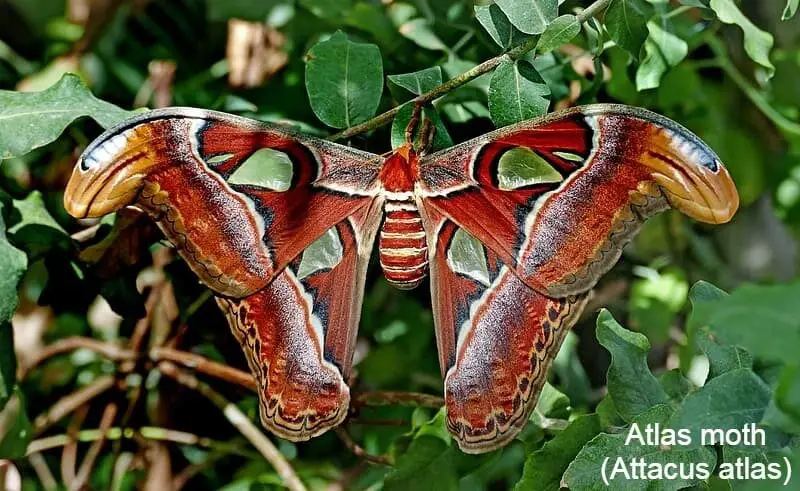
One of the most impressive moths in terms of wing size is found in Asian forests, boasting a surface area that measures at least 400 square centimeters and wings that stretch at least 12 inches long. This remarkable insect’s distinctive appearance is characterized by multicolored wings featuring brown/copper hues with striking white, pink, and purple lines.
What sets this species apart is its unique characteristic of being one of the few moth varieties without a mouth, further adding to its intriguing nature.
Black witch moth (Ascalapha odorata)
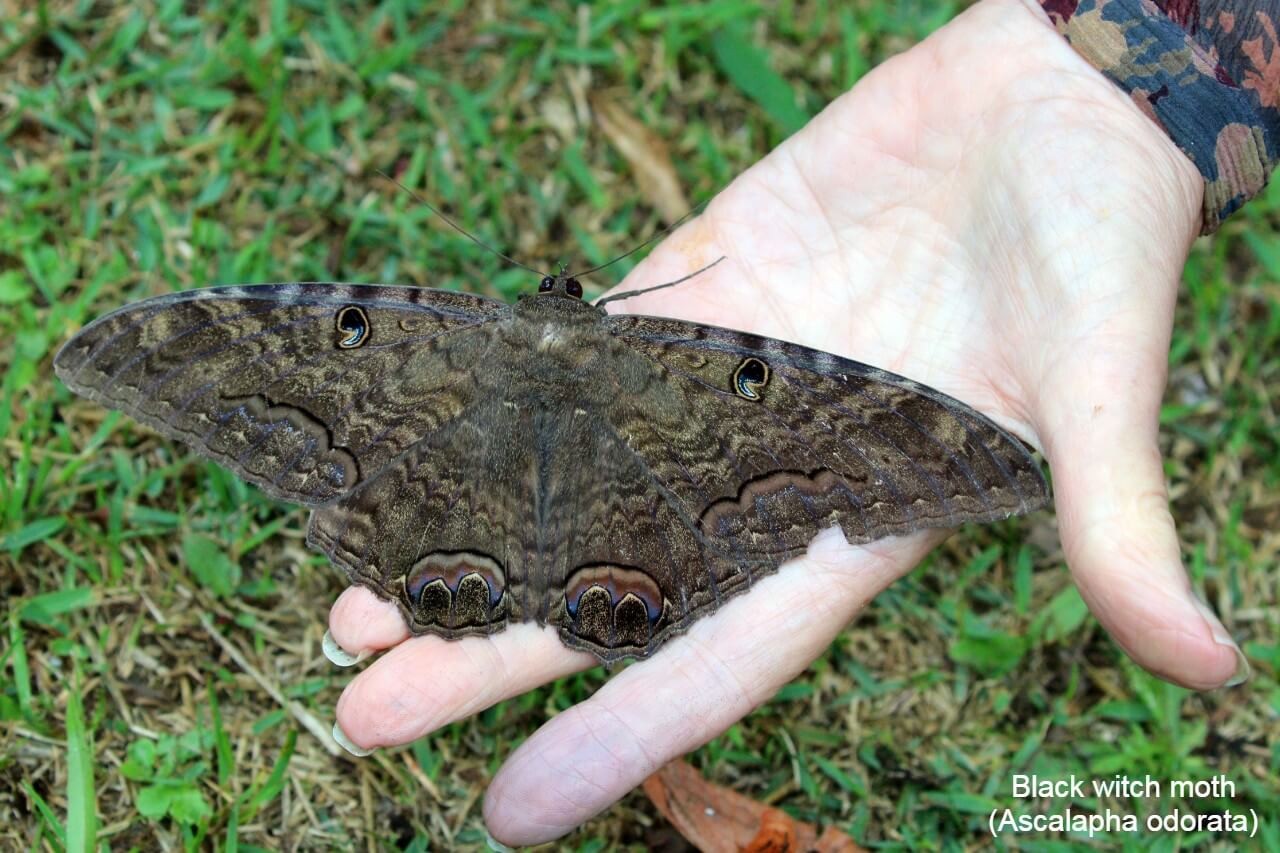
The noctuid species, commonly found in the USA, boasts a distinctive appearance characterized by its elongated, bat-like body shape. Its large black wings feature brown streaks along the lining, while an eye-like structure on the forewings adds to its striking visual appeal. Interestingly, this particular species is endemic to Brazil and other parts of south-central America, making it a unique find for enthusiasts of nocturnal insects.
Brown-tail moth (Euproctis chrysorrhoea)

In the United Kingdom, brown-tail moths are viewed as pests due to their tendency to congregate in large groups on bushes and trees. This nuisance behavior earns them their distinctive name, which stems from the brown and white tufts of hairs surrounding their abdomen. While these moths may seem harmless, they have been known to wreak havoc on orchards in the past. One notable outbreak occurred in the early 18th century, with records dating back to around 1720.
Cecropia moth (Hyalophora cecropia)
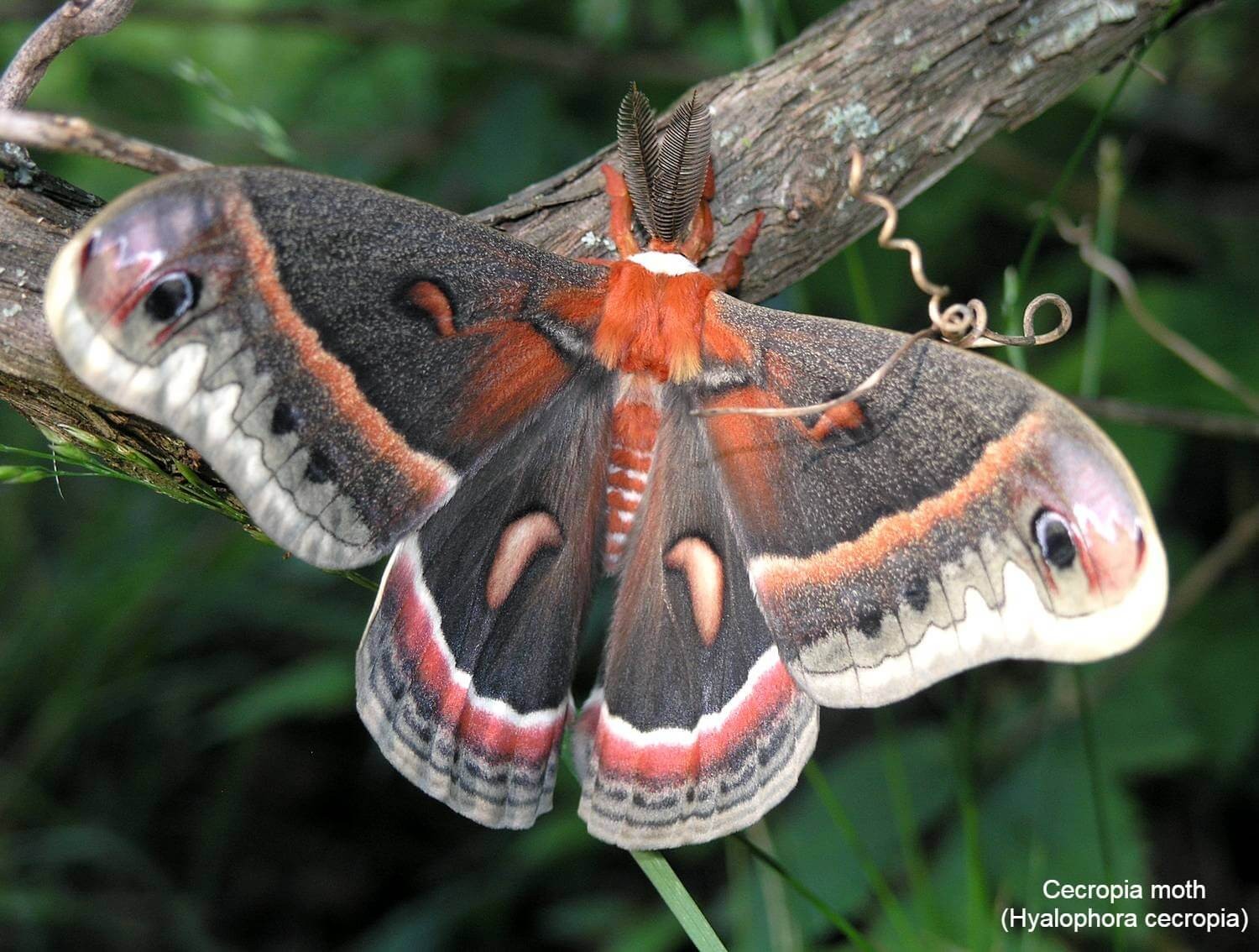
Despite its unassuming wing coloration, this species still exudes charm. Its diminutive antennae and eye-like markings on its wings are striking features. The golden yellow hue of its wings may not be as vibrant as some others, but it’s no less captivating. With a relatively modest wingspan of just 6 inches, the silk moth earns its name from the valuable silk it produces, making it an important part of the giant silk moth family.
Cinnabar moth (Tyria jacobaeae)
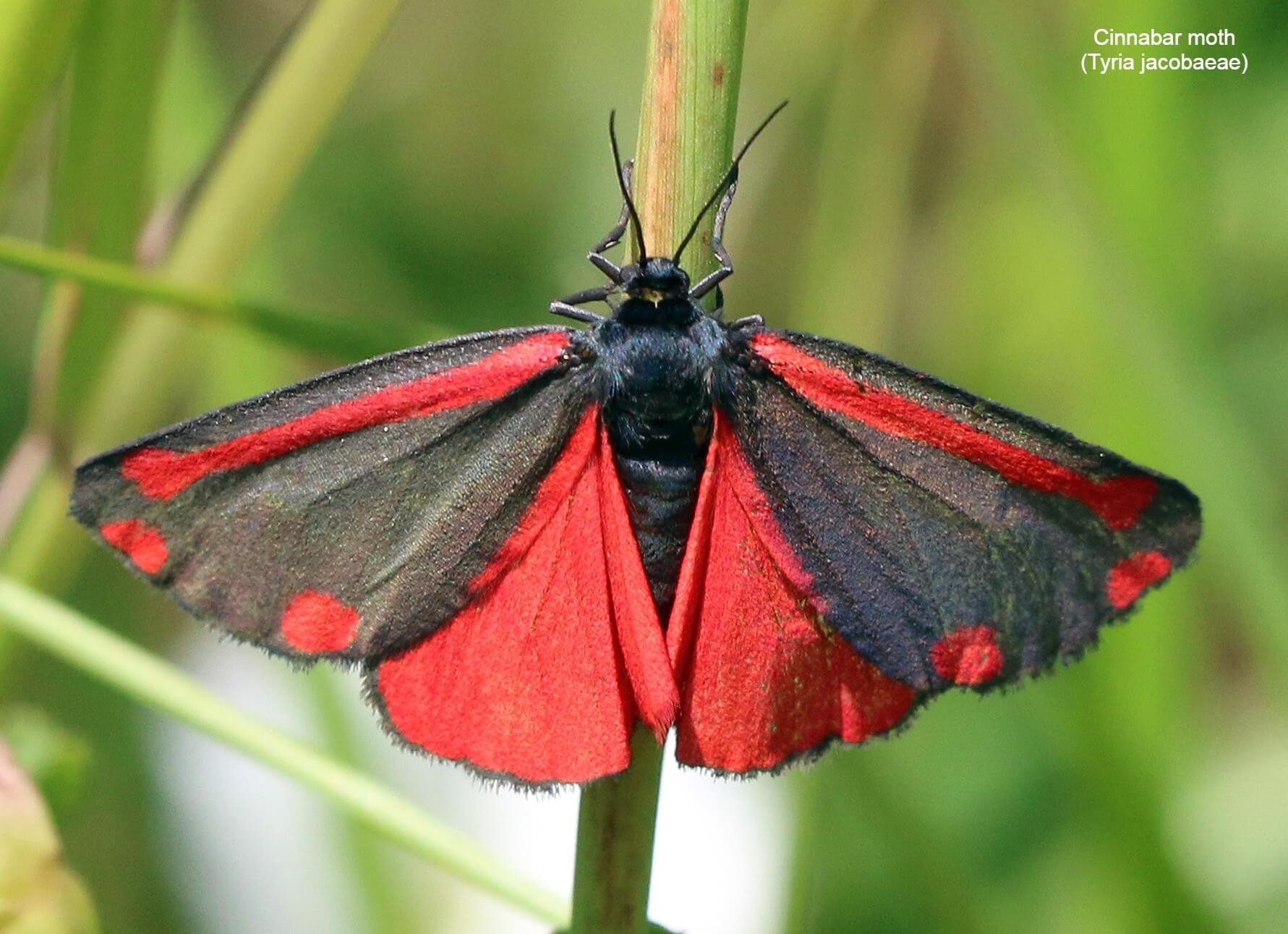
The striking Erannis tiliaria moth, with its bold red and black wings and forewings, is a native European and Central Asian species that has been introduced to various regions of the world. The motivation behind this introduction lies in its unique feeding behavior – it preys on the invasive ragwort. Additionally, its vibrant coloration plays a crucial role in deterring predators, as they mistakenly assume the moth’s bright hue signals poisonousness, thereby avoiding an attack.
Codling moth (Cydia pomonella)
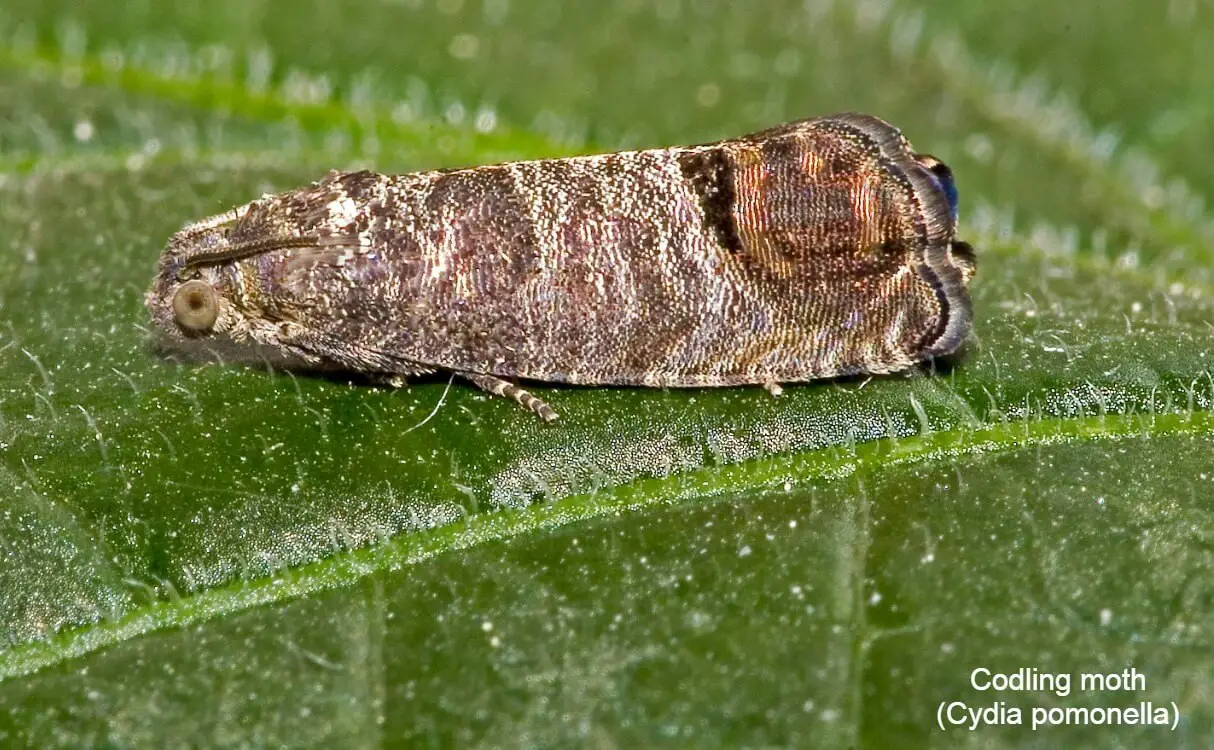
The lesser-known threat posed by these pests lies in their voracious appetite for fruits like apples and pears, which they devour with relish. The larvae’s inability to feed on leaves leads to premature ripening, causing significant damage to crops. While the adult moths themselves don’t grow much larger than 20mm in wingspan, the impact of their feeding habits is substantial.
Comet moth (Argema mittrei)
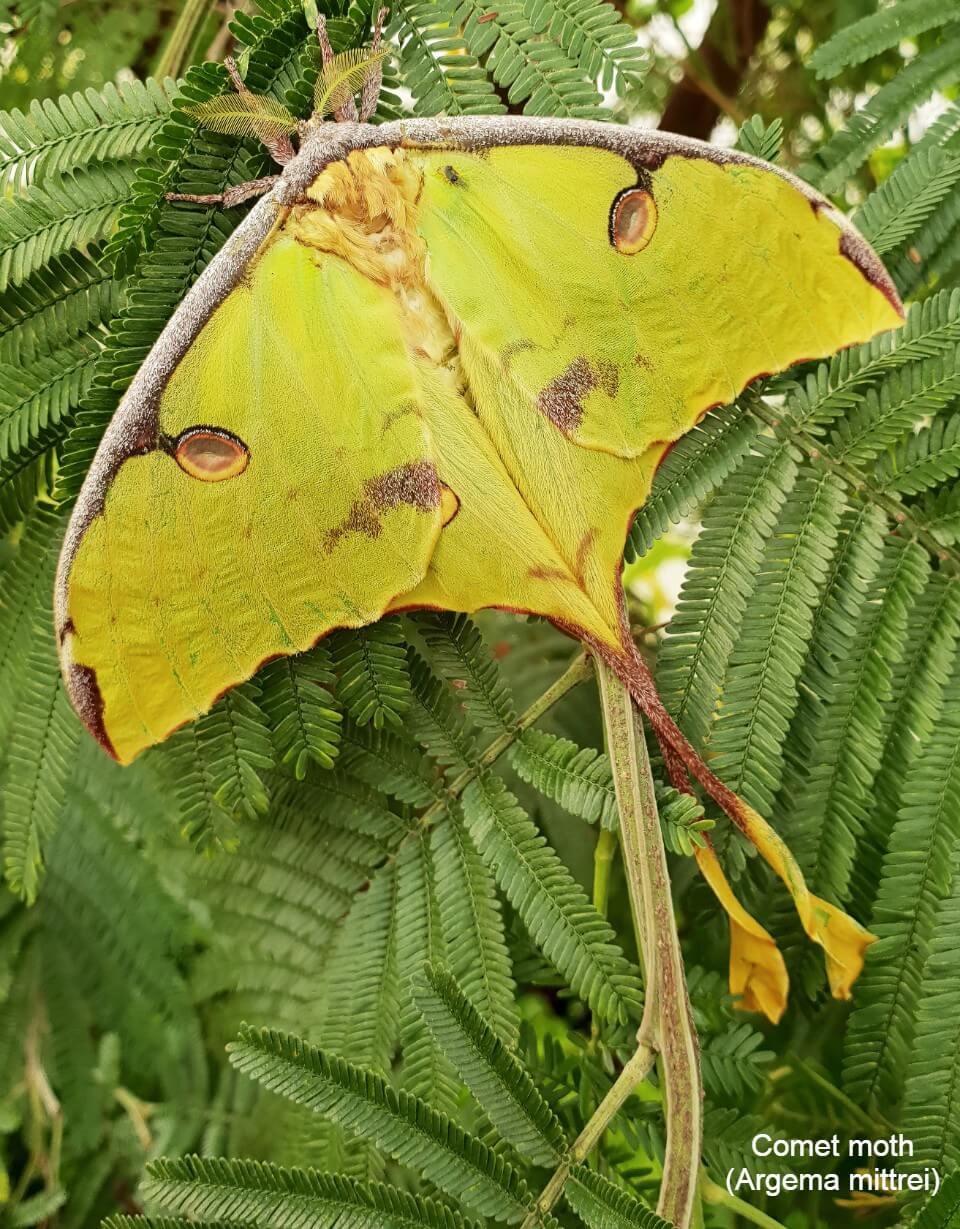
Deep within the rainforests of Madagascar lies a moth species unlike any other. Its impressive wingspan can stretch up to an astonishing 20 centimeters, making it one of the largest silk moths in the world. The insect’s wings boast a vibrant yellow, brown, and subtle green hue, punctuated by black linings and striking dark orange circles. One of its most distinctive features is the long, slender tails that can reach lengths of up to 15 centimeters, earning it its unique name.
Interestingly, these moths do not possess mouths and have a relatively short lifespan, adding to their mystique.
Death’s-head hawkmoth (Acherontia atropos)
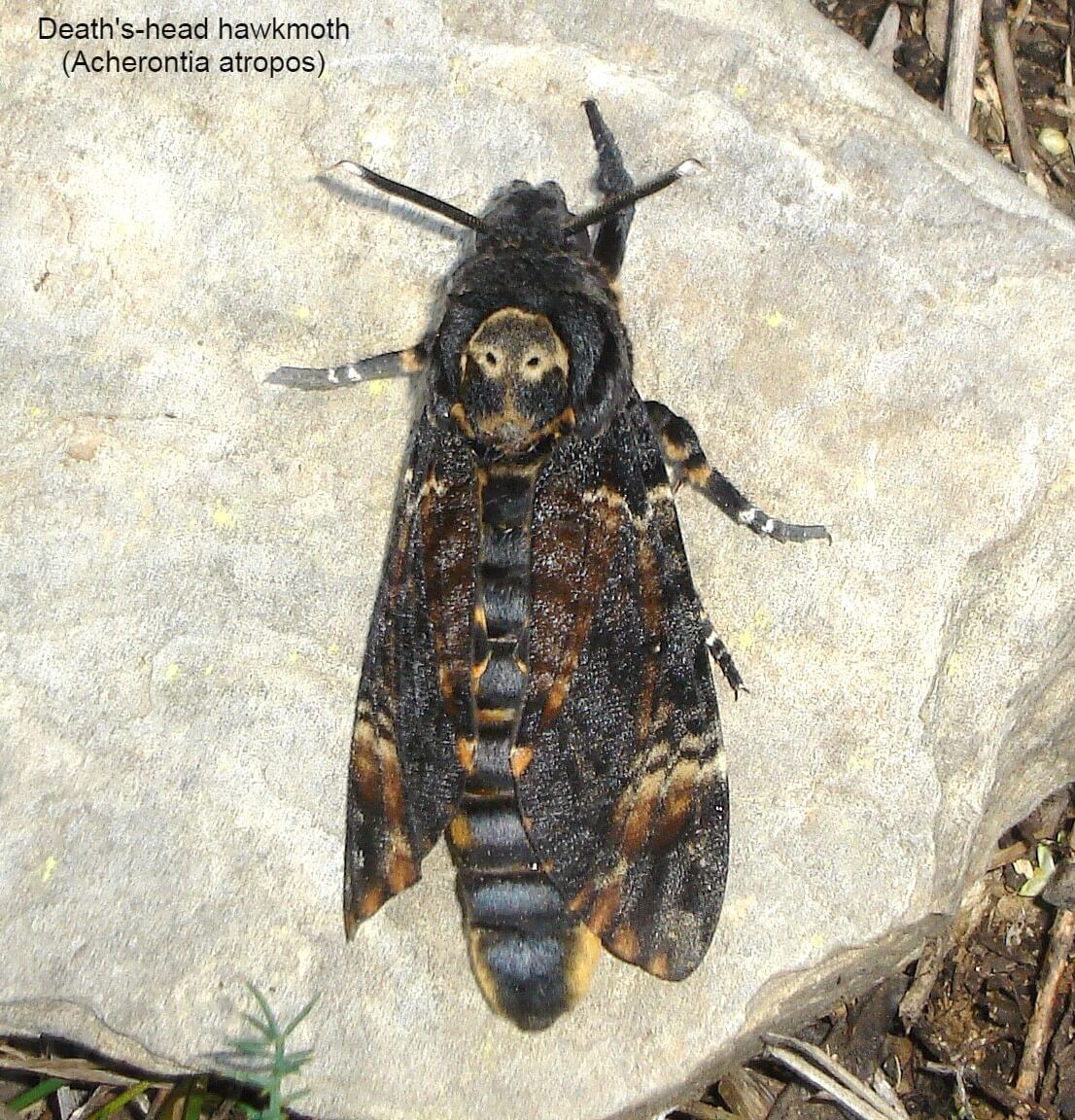
The iconic Death’s-head Hawkmoth, made famous by its appearance in The Silence of the Lambs, owes its notorious reputation to the skull-like markings on its abdomen. This symbolism is rooted in ancient associations with bad omens and death. Its genus, Acherontia, derives from the Greek concept of the underworld’s River of Pain, Acheron. Characterized by a striking dark brown coloration with white or light brown streaks, this moth’s unique appearance only adds to its eerie allure.
Ethereal moth
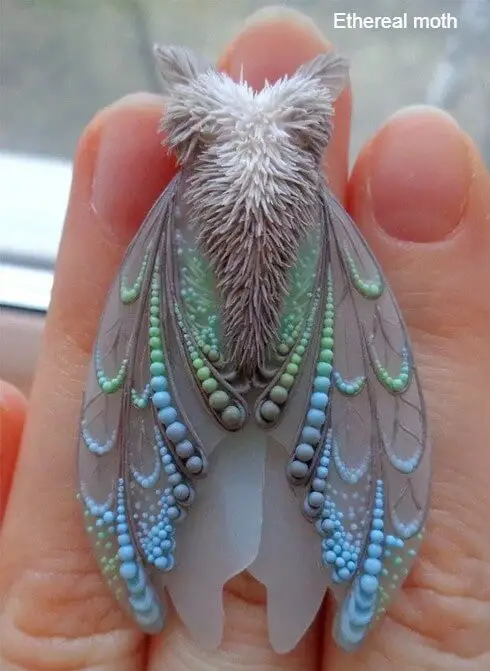
These enigmatic creatures possess an otherworldly beauty, with translucent wings adorned by intricate, three-dimensional granules that seem to defy reality. Their fine, fluffy head hairs add to their whimsical appearance, leaving onlookers questioning whether they’re indeed real or a product of imagination. The rarity of these moths only serves to heighten the sense of wonder and magic that surrounds them.
Five-spotted hawk moth (Manduca quinquemaculata)
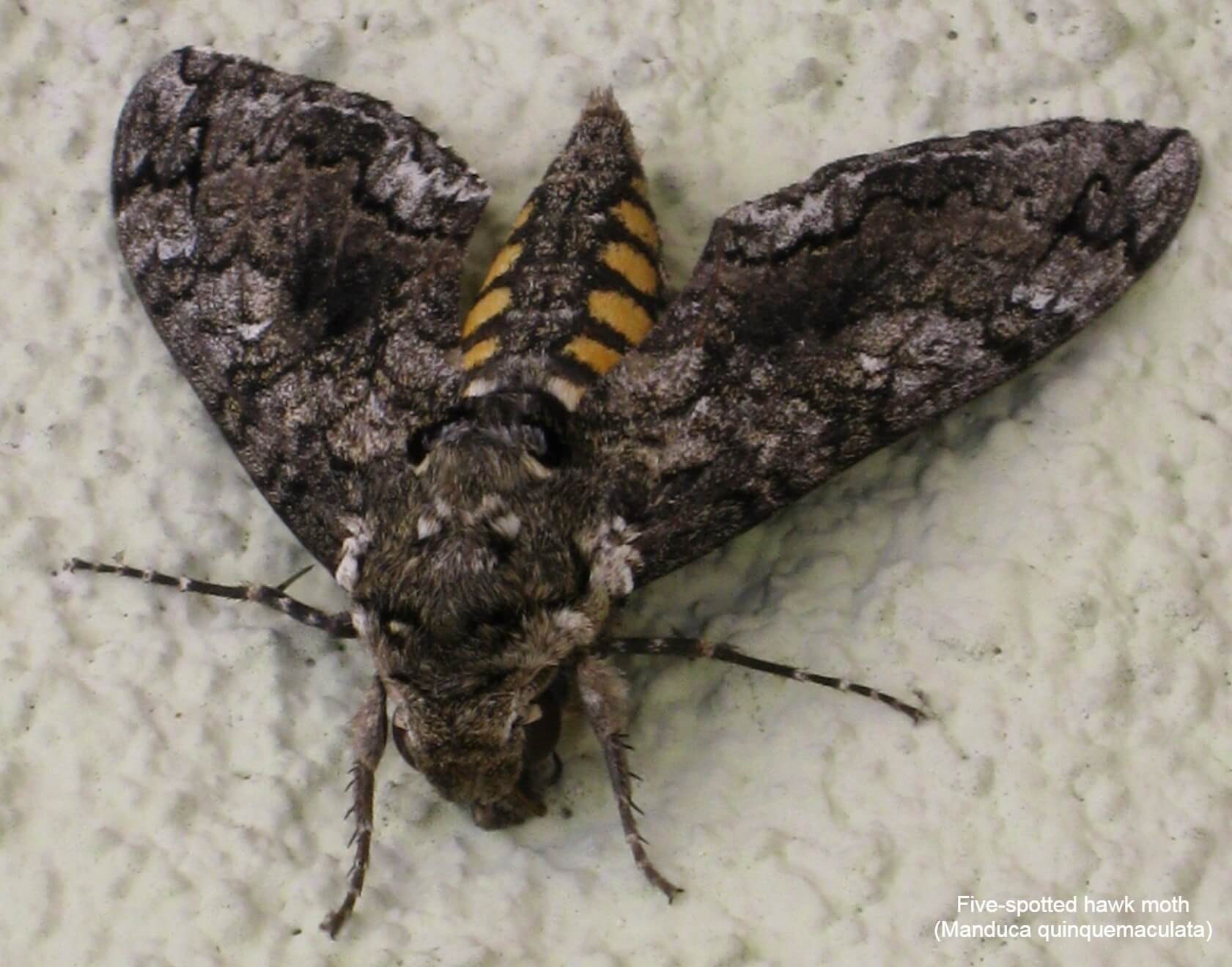
The fifth instar larva of the Five-spotted Hawk Moth, also known as the Tomato Hornworm due to its potential to wreak havoc on tomato crops and tobacco fields, is a striking insect with wings displaying a remarkable array of colors. The gray, white, black, yellow, orange, and pale green hues make for an intricate pattern that sets it apart from other moths. Native to Mexico and the United States, this species plays an important role in its ecosystems, serving as both a food source and predator.
Flannel moth (Megalopygidae)
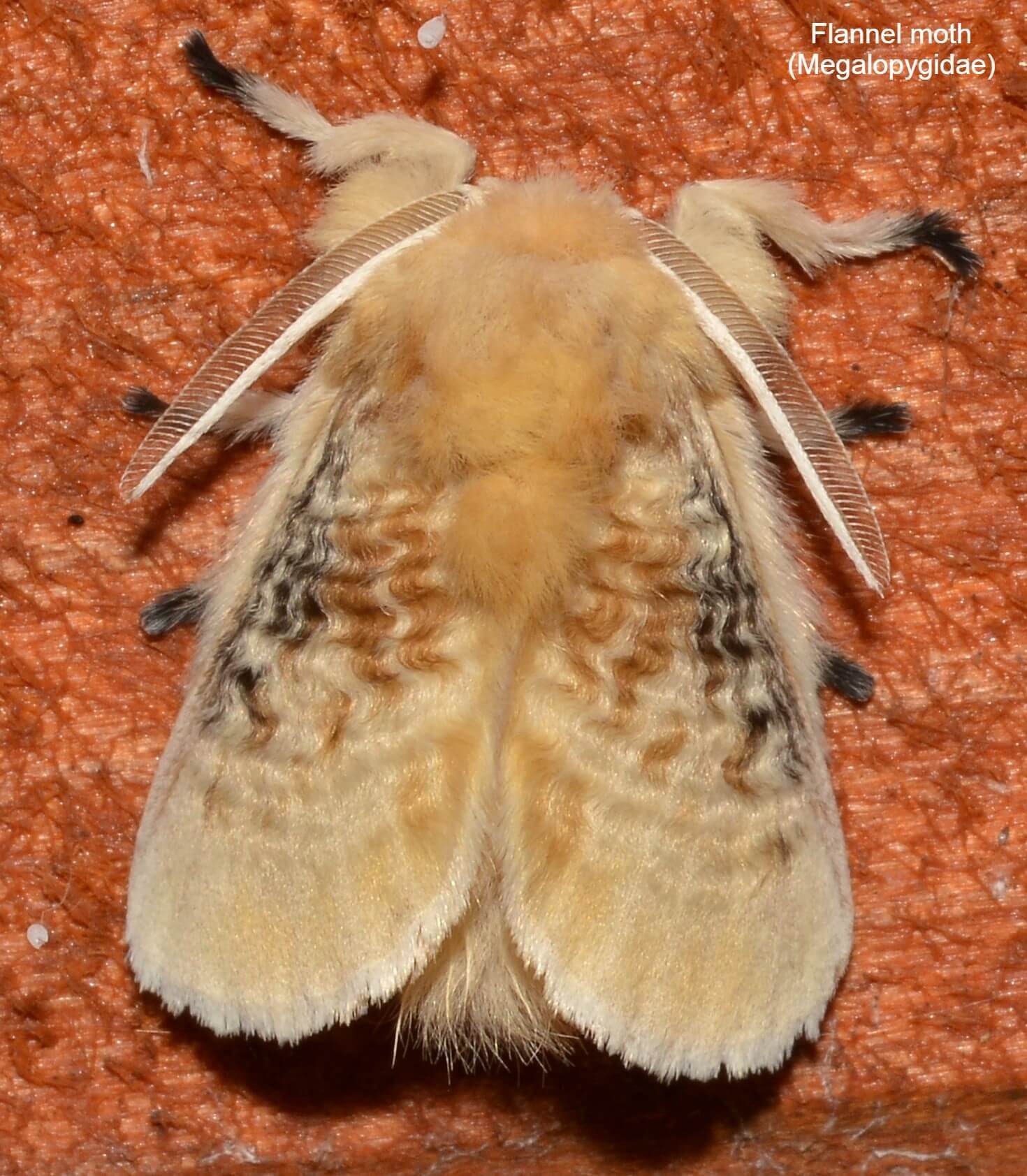
The puss caterpillar’s most distinctive feature is its furry body, which causes it to resemble a large cotton ball when curled up. But beneath this adorable exterior lies a warning: the spines of these larvae are actually venomous and can cause painful stings if not treated promptly. When they unfurl, their bright coloration may evoke memories of a bee, but don’t let that fool you – these caterpillars pack a potent punch.
Giant leopard moth (Hypercompe scribonia)
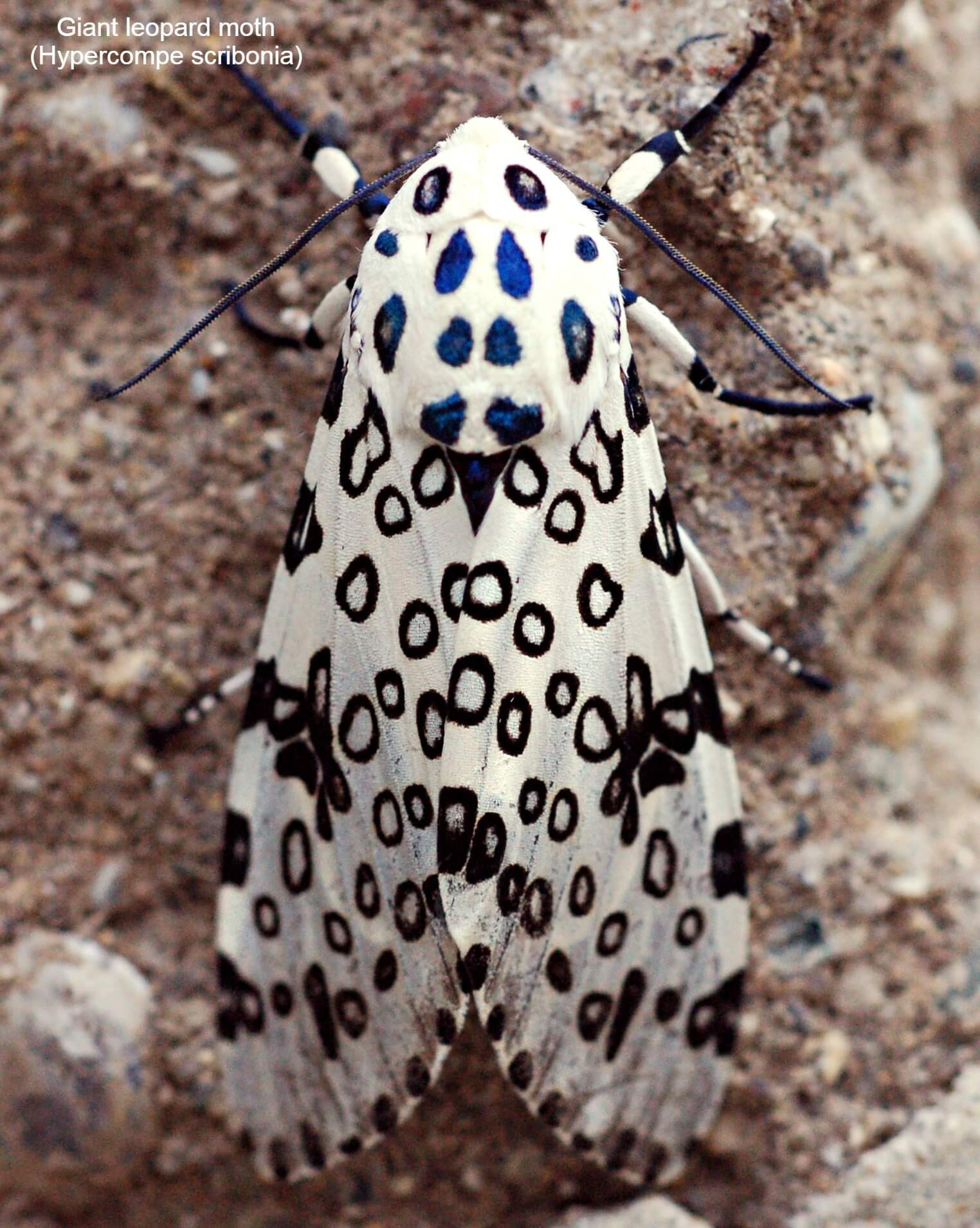
The majestic species in question can be found thriving in the regions of southcentral America, northern America, and southern Canada. Its striking appearance features bright white wings adorned with scattered black spots and irregular streaks. The underside of its body is characterized by a dark blue hue punctuated by prominent orange markings. Moreover, its midnight blue legs are distinguished by white bands. Notably, this Eribidae exhibits a considerable wingspan of at least 76mm.
Gypsy moth (Lymantria dispar dispar)
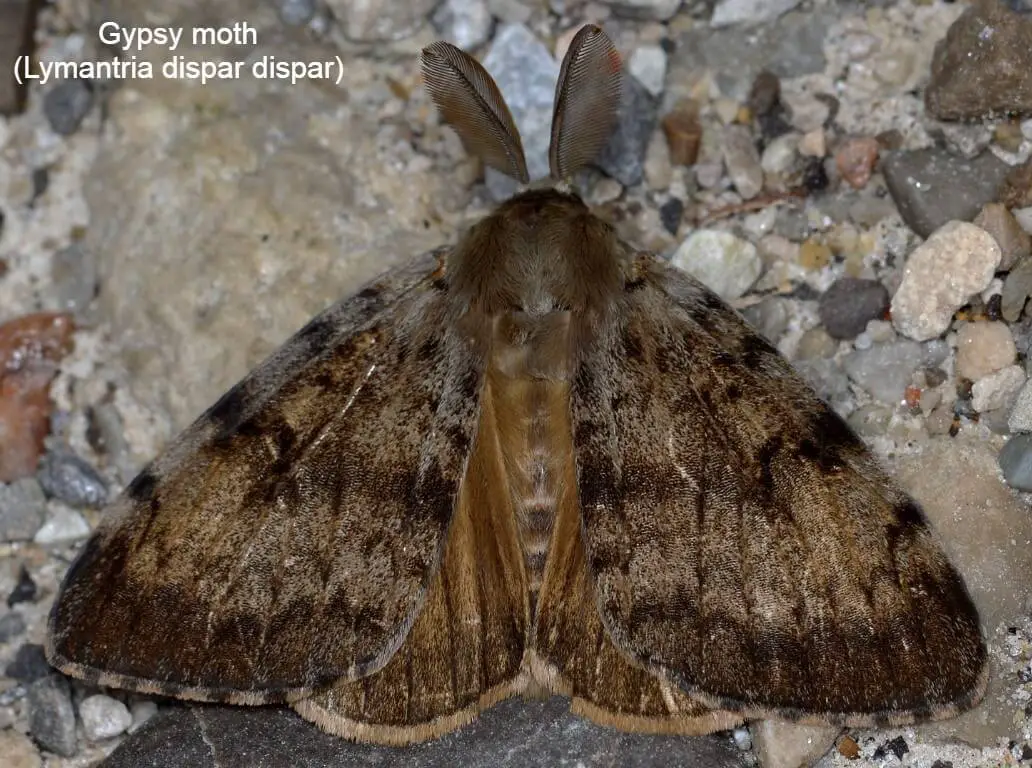
One of the most fascinating aspects of gypsy moths is their diversity across different subspecies. The Japanese, European, and Asian varieties each exhibit distinct characteristics that set them apart from one another. For instance, female gypsy moths tend to have a more pronounced difference in wingspan size compared to males. Interestingly, the European gypsy moth stands out for its unique flightless nature, while Japanese females are drawn to artificial light sources.
Meanwhile, Asian species boast dark brown and larger male specimens, showcasing the remarkable range of physical characteristics within this group.
Hag moth (Phobetron pithecium)

The slug moth family boasts a fascinating species in the form of the hag moth. A closer look at its larvae reveals an unsettling yet intriguing sight, as they feature bodies covered in short, dark brown hairs and tentacle-like appendages. This unusual appearance is only surpassed by the adults, which remain remarkably hairy even down to their legs. In contrast, their wings are translucent, while it’s the black and brown hair tufts that give them their distinctive coloring.
Hawk moth (Sphingidae, sphinx moth)
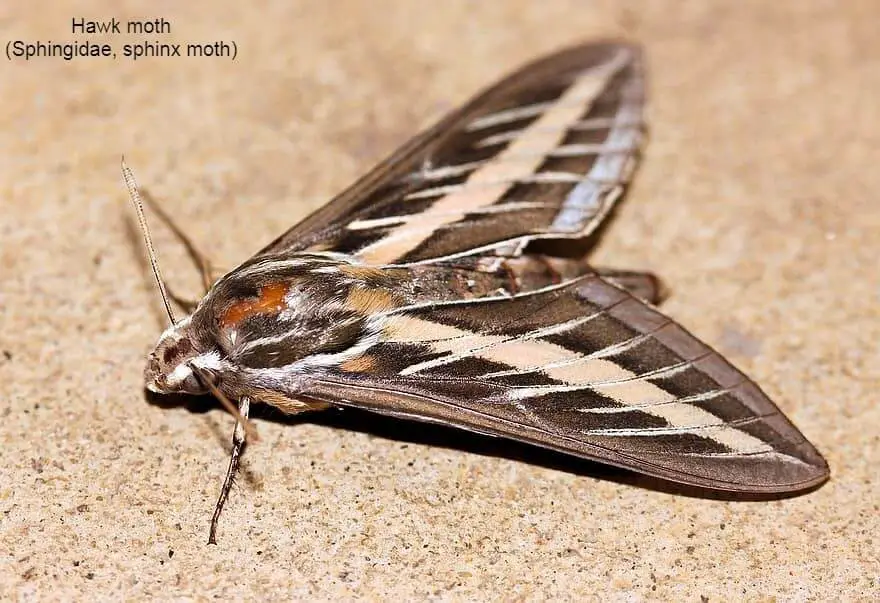
With over 1,450 species recognized worldwide – excluding Antarctica – this type of moth boasts an impressive global presence. Characterized by their robust bodies and elongated, slender wings, they are a distinct and fascinating group. One of their most notable features is their remarkably long tongue, which allows them to feed on brightly colored flowers in the darkness.
Hercules moth (Coscinocera hercules)
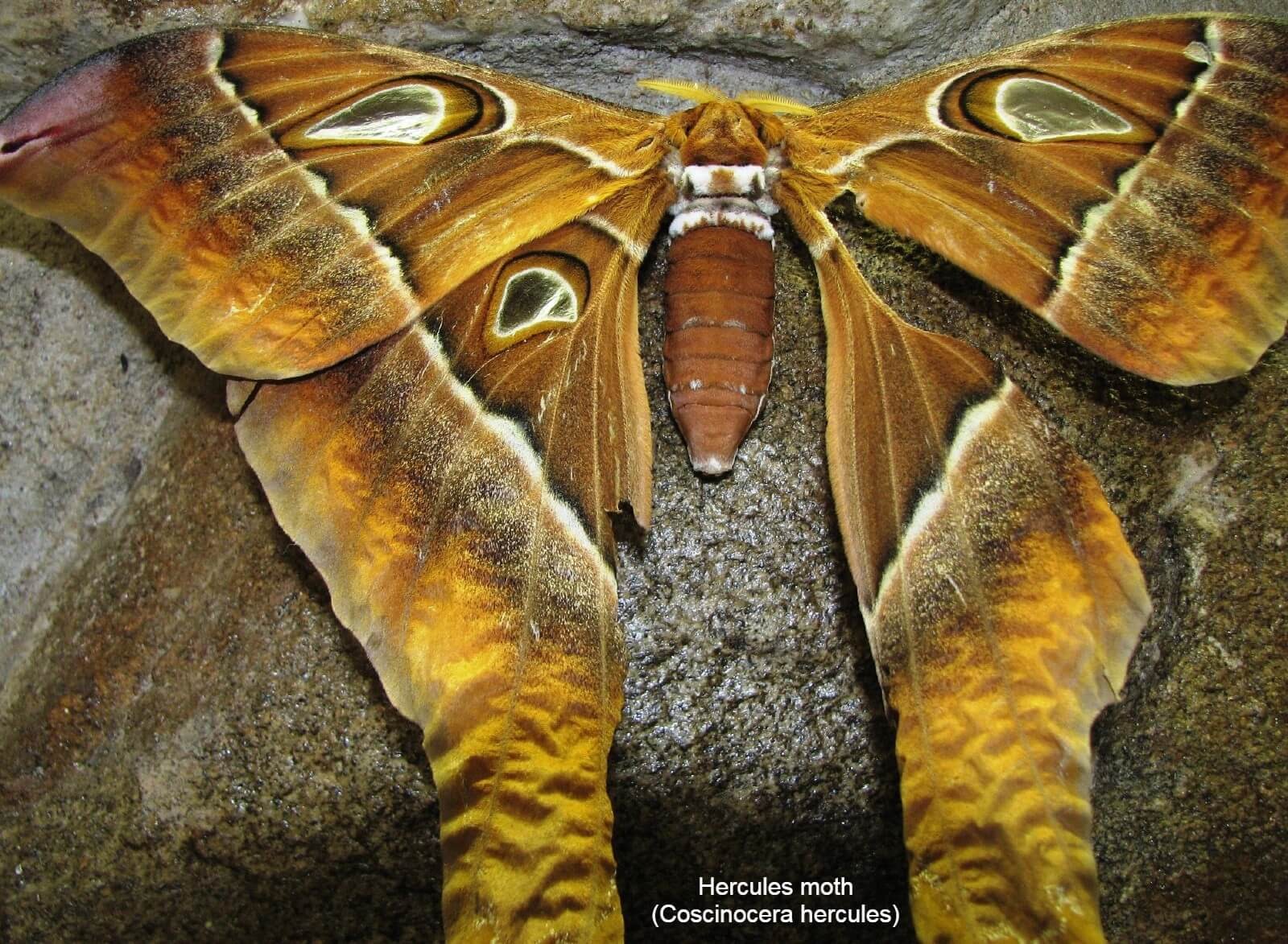
The Australian native, Queensland’s largest moth species, boasts an impressive wingspan of up to 27cm. Its caterpillars are particularly fond of the bleeding heart tree, where they spend their days feeding and weaving silk cocoons around the tree’s branches. In this unique process, the caterpillars create a protective shield for themselves as they prepare for metamorphosis.
Notably, female Hercules moths exhibit distinct physical characteristics compared to males; they possess a more robust build and shorter tails. Once these moths reach adulthood, they cease feeding altogether and have a relatively short lifespan of just 14 days.
Hummingbird hawk moth (Macroglossum stellatarum)
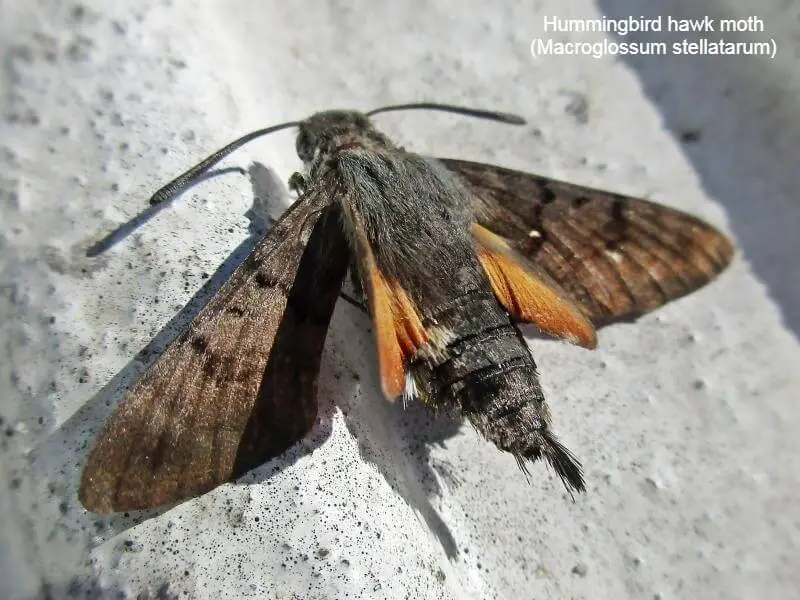
This unique insect earns its name due to its remarkable behavior, which involves hovering around flowers using its long, tube-like proboscis much like a hummingbird flits from bloom to bloom. Despite its small size and dull coloring, the insect boasts an impressive wingspan of just over one and a half inches. In fact, its rapid wing movement as it hovers towards flowers can be so convincing that it’s often mistaken for a tiny hummingbird.
Imperial moth (Eacles imperialis)
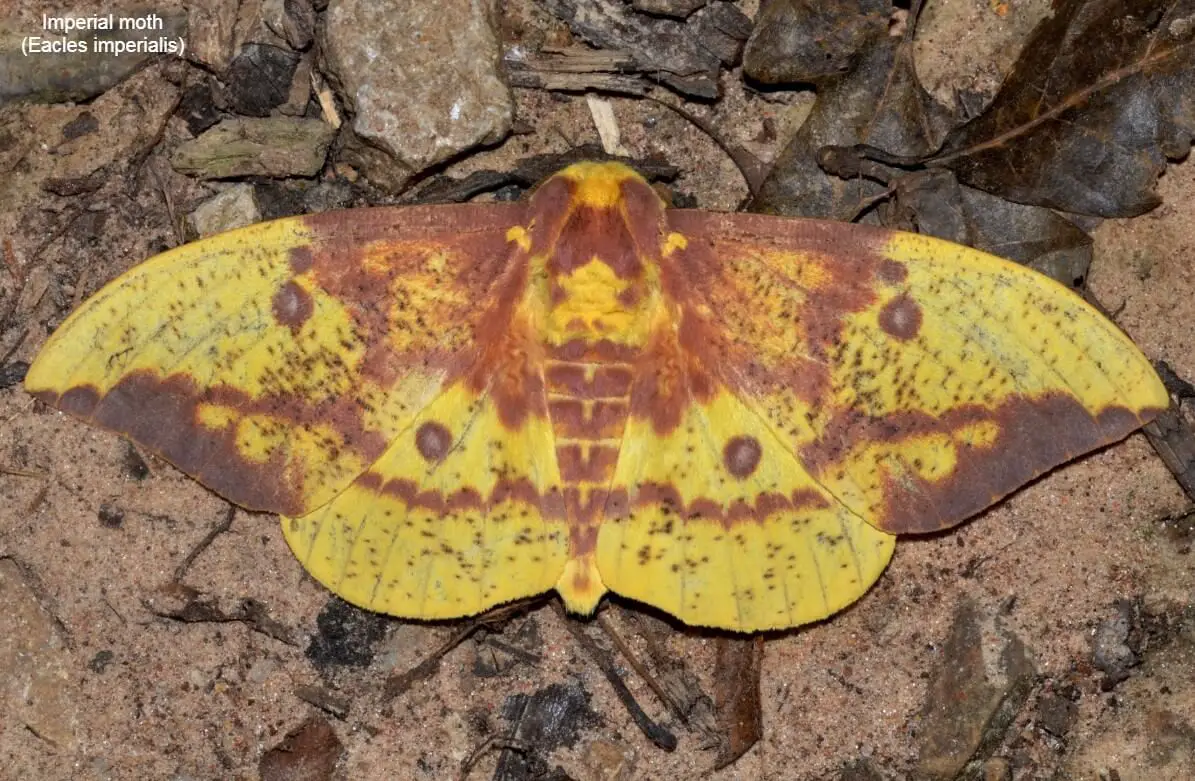
Within the realm of the giant silk moth family, a specific species stands out for its striking appearance: the royal moths. Characterized by their vibrant yellow wings, adorned with intricate brown lines and black spots, these magnificent creatures are a treat to behold. However, it’s not just their visual appeal that sets them apart – their caterpillars also boast an unusual feature: long, black spines capable of inflicting a painful sting.
When it comes to their habitat preferences, royal moths tend to favor large trees, including oaks, pines, and maples.
Indianmeal moth (Plodia interpunctella)
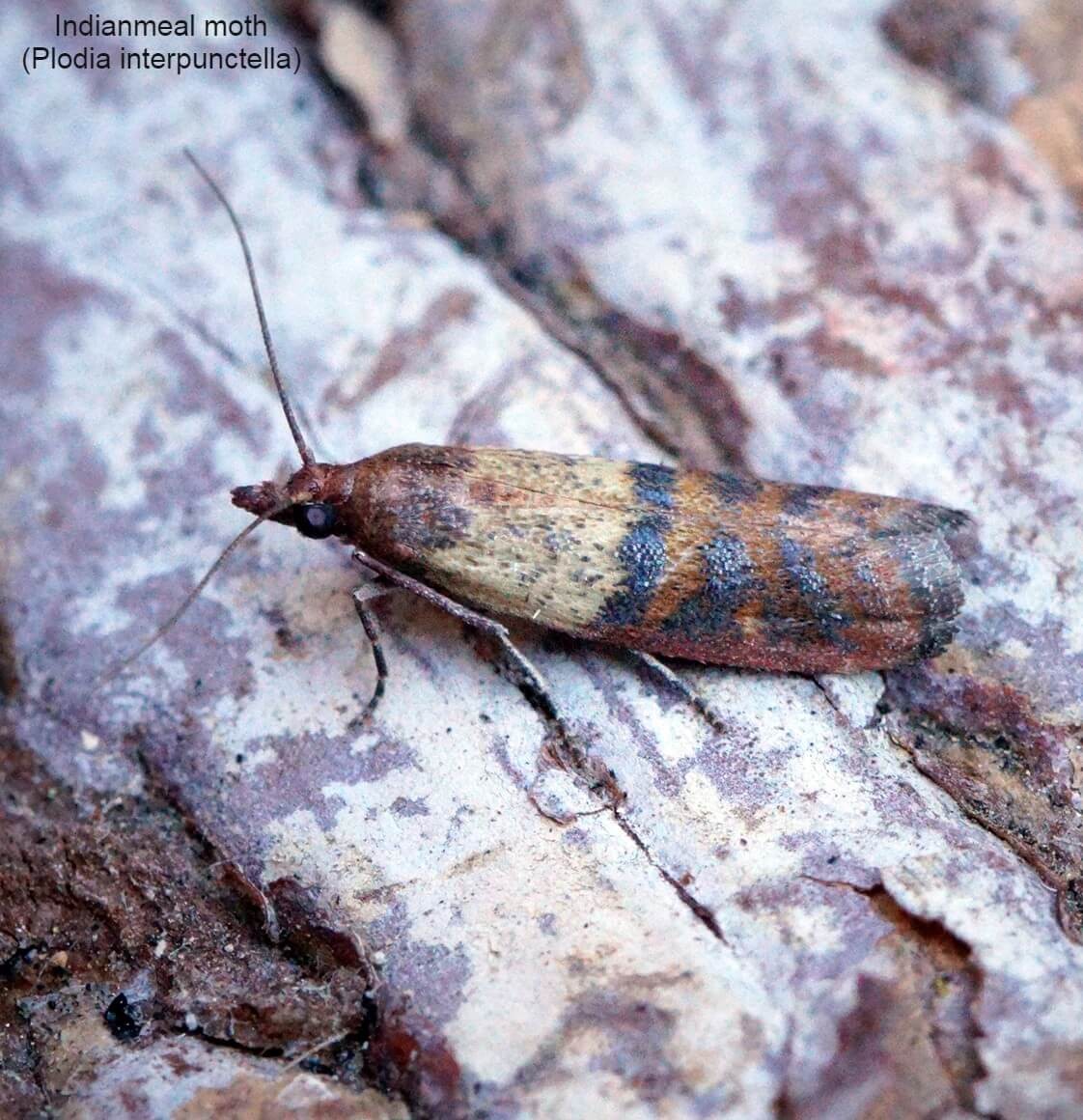
The Indian corn moth, also known as the grain or flour moth, owes its name to its affinity for maize and other grains. This American pest is well adapted to thriving in tropical climates, characterized by its striking red-brown forewings featuring subtle tinges of bronze and dark gray. Notably, it has a modest wingspan of 20mm and a body length of approximately 10mm. Florida, with its warm and humid climate, provides an ideal environment for this insect to flourish in vast numbers.
Isabella tiger moth (Pyrrharctia isabella)
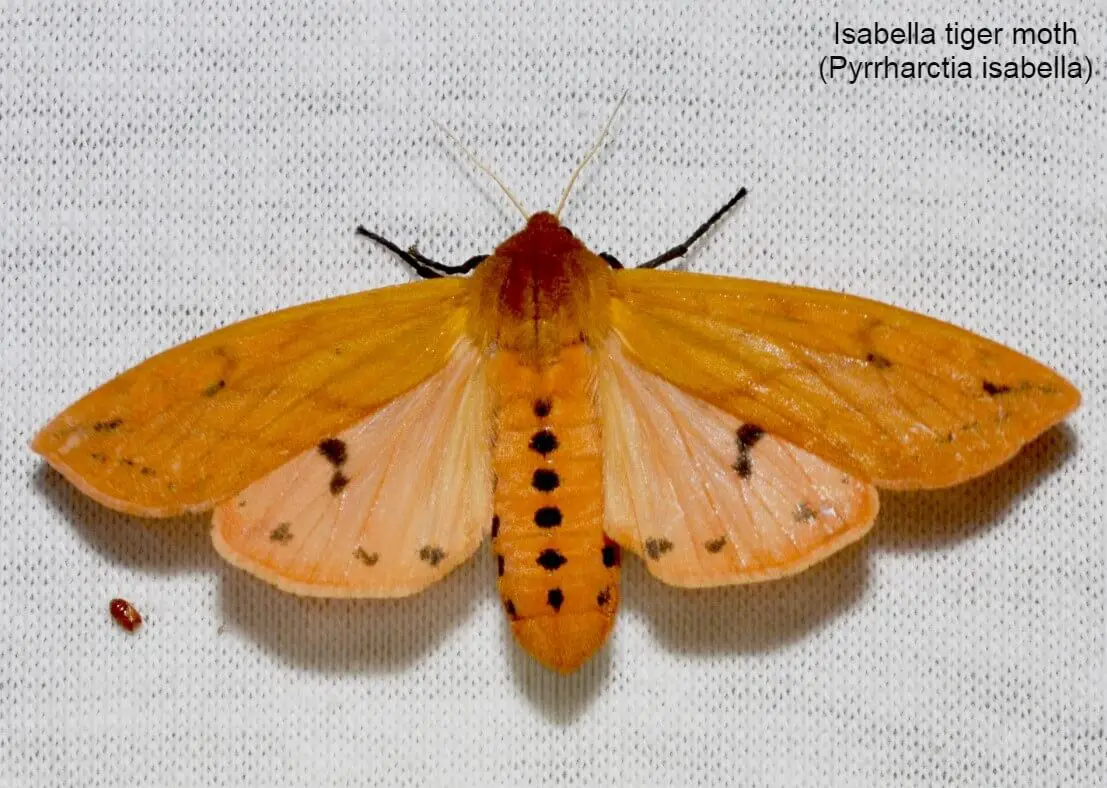
The woolly bear moth is also widely recognized in the southern United States and Canada. Its larvae are notable for their striking multicolored patterns, consisting of alternating black-brown-red-black segments. In contrast, adult tiger moths exhibit a more subdued appearance, characterized by pale yellow bodies covered in scales, and orange-yellow wings with distinctive markings on their forewings.
Interestingly, these moths are classified as generalist feeders, as they consume a wide variety of plant life.
Luna moth (Actias luna)
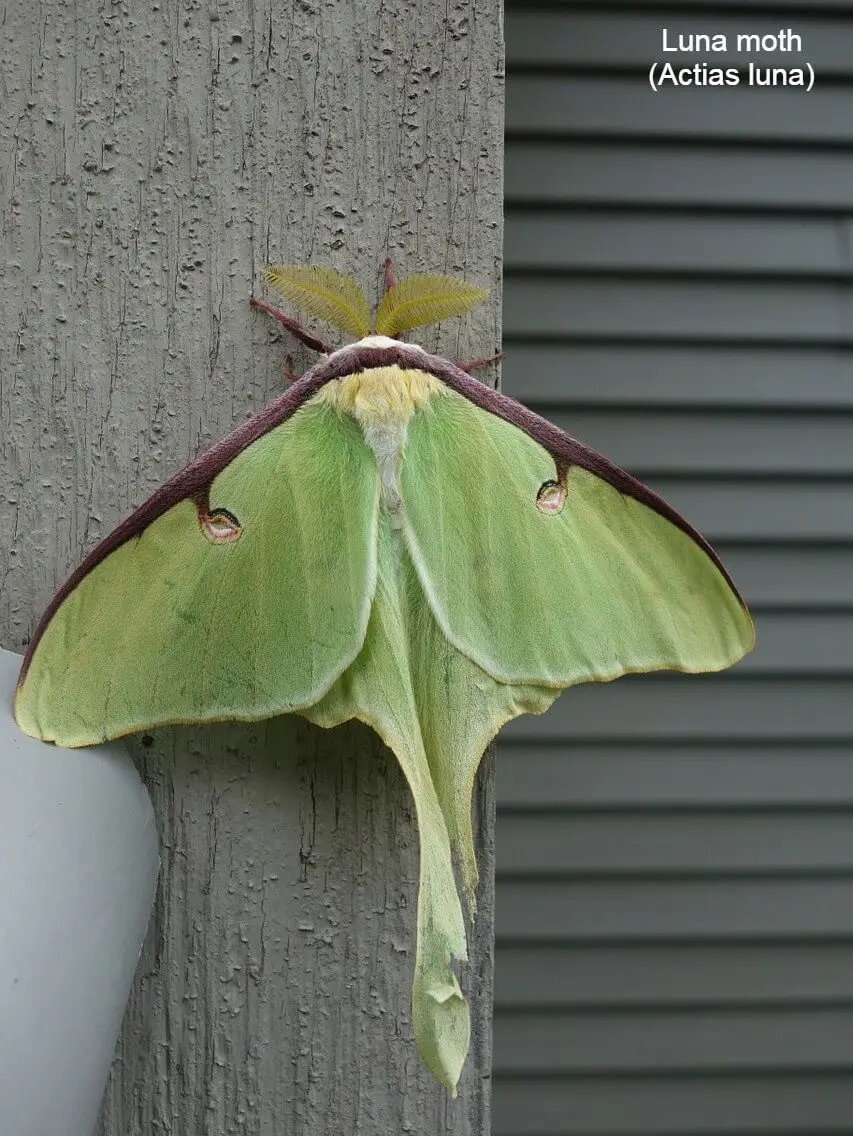
The American Moon moth, also known for its striking appearance, boasts a white body and vibrant lime green wings. Notably, it is one of the largest moths in North America, with a maximum wingspan reaching 178cm. Its unique feature is not just its impressive size, but also its long, curved tails adorned with eye-catching spots featuring a range of colors – green, black, yellow, red, or blue.
Milkweed tussock moth (Euchaetes egle)

The Monarch butterfly’s namesake moth is a unique creature that thrives on milkweeds, its primary food source. Its striking orange, brown, and black coloration serves as a warning to potential predators, signaling that they are toxic or poisonous. Notably, the caterpillar stage of this moth’s life cycle is particularly deadly, thanks to the presence of cardiac glycosides in milkweed sap.
When threatened, these chemicals can be released through the moth’s sting, making it a formidable defense mechanism against would-be attackers.
Miller moth (Acronicta leporina)
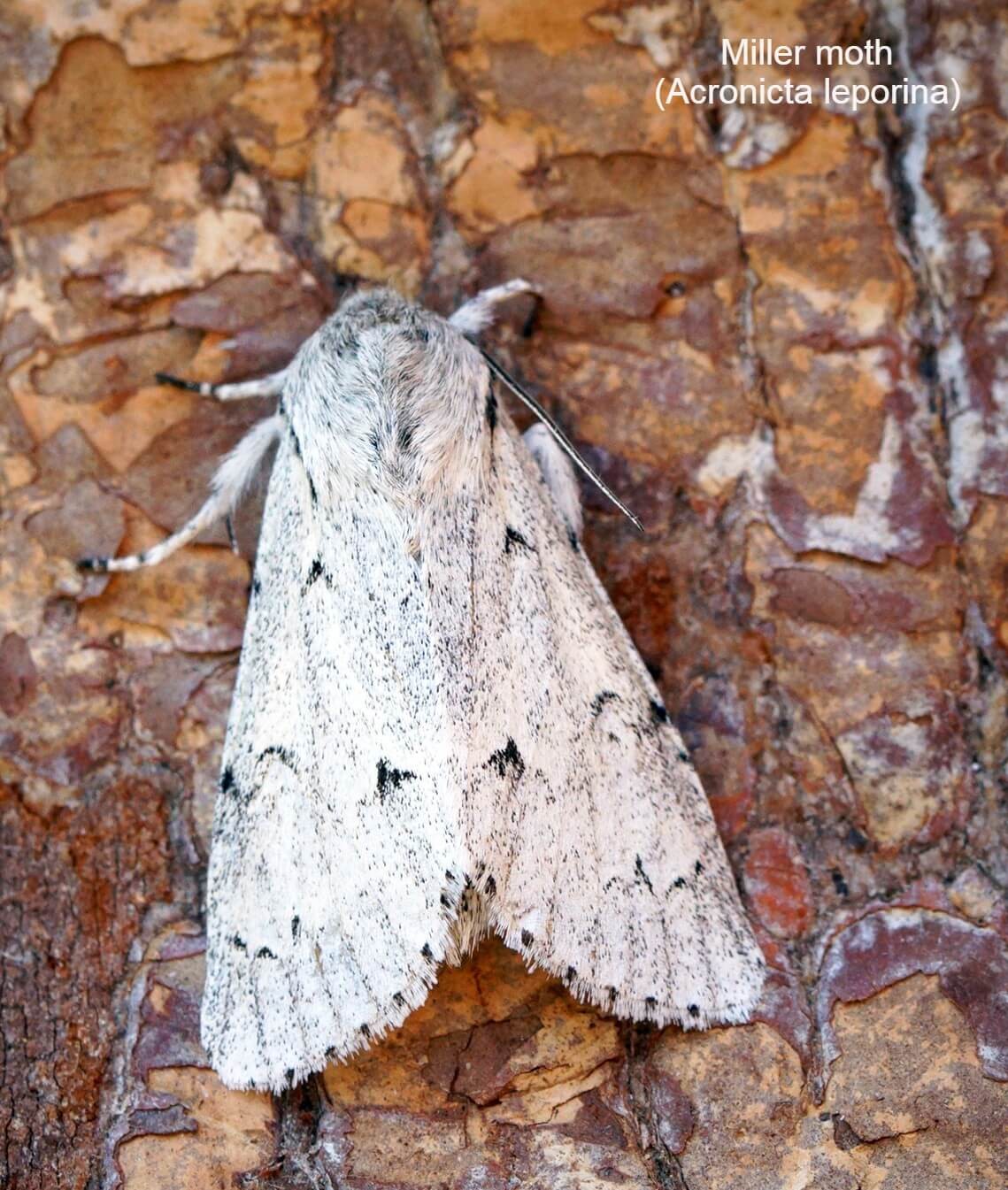
When the temperature drops, a particular species of moth embarks on an annual migration, traversing different regions to reach their destination. Another fascinating example is the Army cutworm, which undergoes a remarkable transformation at maturity. As they mature, these moths shed their skin and emerge as Miller moths, having a surprisingly short lifespan of just three weeks.
Interestingly, Miller moths are characterized by their dusty, pale brown wings, which feature dark brown linings that add to their distinctive appearance.
Owl moth (Brahmaea wallichii)

The majestic Brahmin moth, a behemoth among its peers, is characterized by its striking visual feature: an oversized eye-like mark that resembles an owl’s gaze when the moth is in flight. This remarkable spot serves as a unique identifier for this species, which thrives on a diet rich in fermenting fruits, particularly those from fruit trees.
Pandora moth (Coloradia pandora)
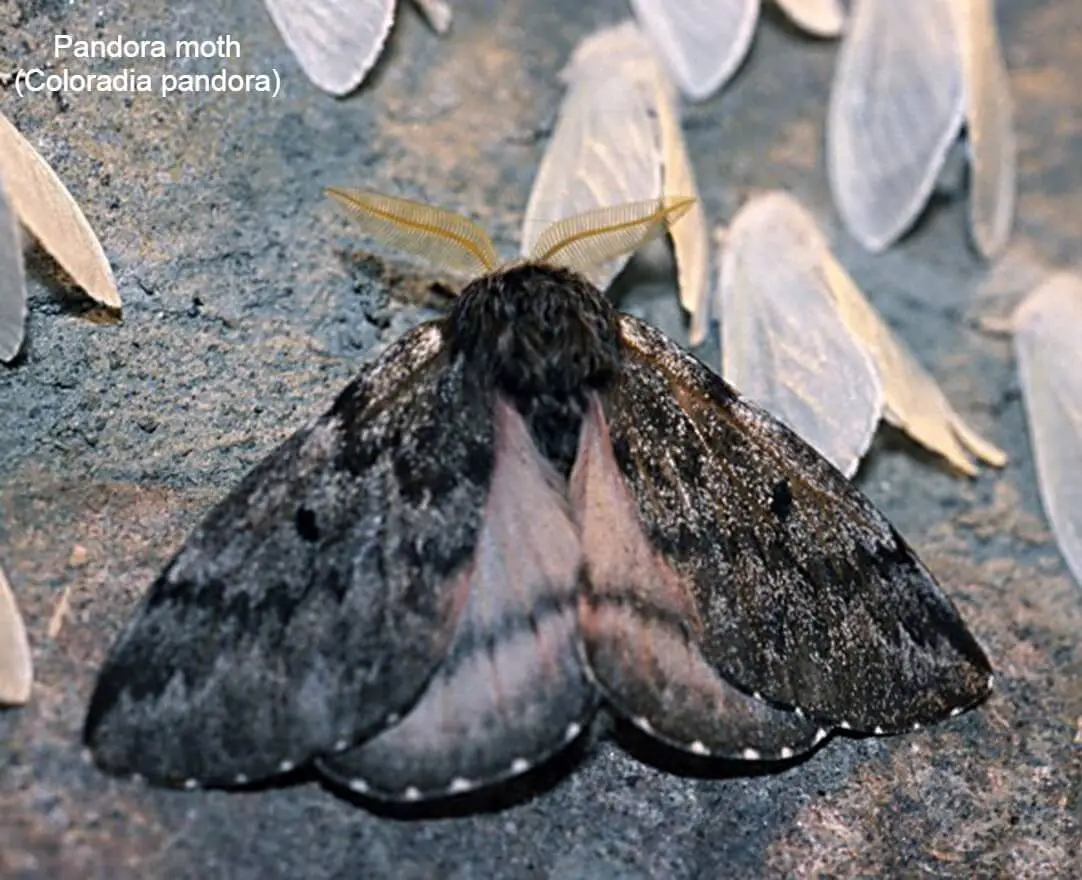
The Western US is home to one of the most notorious pine defoliators: the caterpillar of the Pandora moth. These larvae have a particular fondness for lodgepole and ponderosa pines, leaving behind a trail of destruction in their wake. Characterized by their hairy bodies, these critters come in a range of colors, including black, pale, and dark brown hues.
Peppered moth (Biston betularia)

The fascinating Darwin’s moths are easily recognizable due to their striking cookies and cream-colored bodies and wings. This unique coloration serves as an effective camouflage, allowing them to blend seamlessly into their surroundings as they rest among lichen-covered tree trunks. Characterized by plump bodies and long, narrow wings, these intriguing creatures have evolved remarkable adaptations for survival.
Plume moth (Pterophoridae)
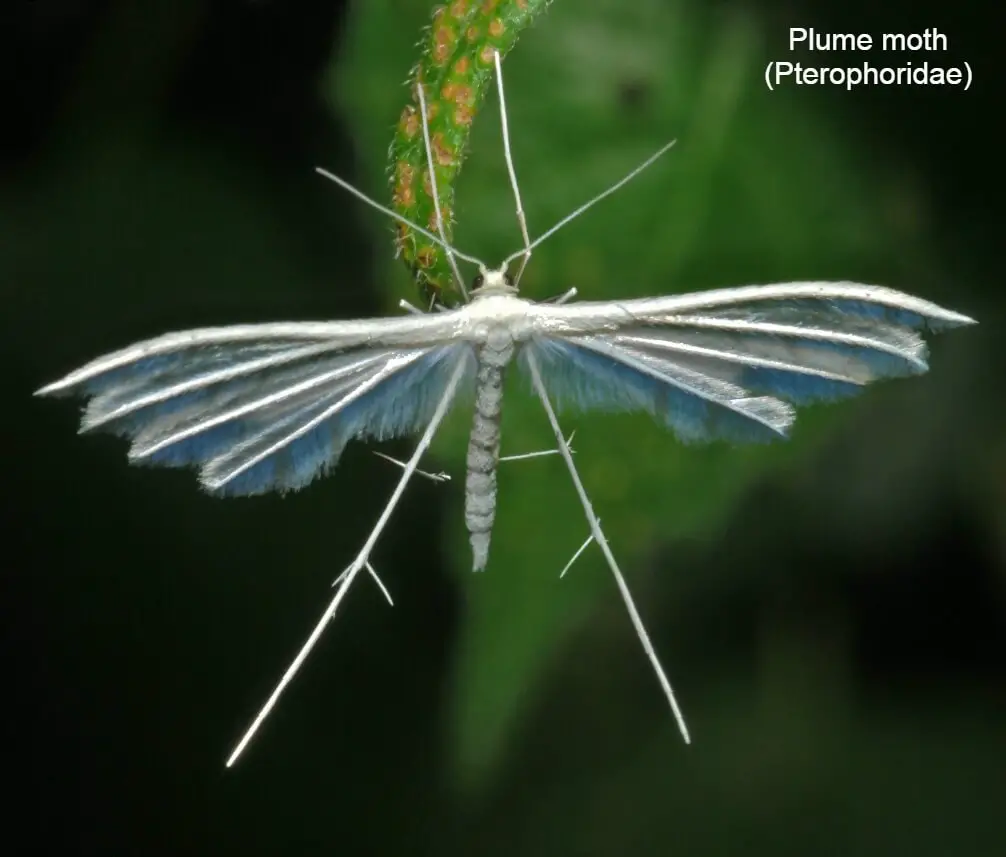
The morning glory moth gets its name from its unique feeding habits – it’s a fan of morning glories! At first glance, this species bears some resemblance to skippers, thanks to its elongated and narrow green body and wings. When its wings are fully extended, the morning glory moth presents an intriguing T-shape silhouette, accompanied by delicate, curled legs that add to its charm.
Polyphemus moth (Antheraea polyphemus)
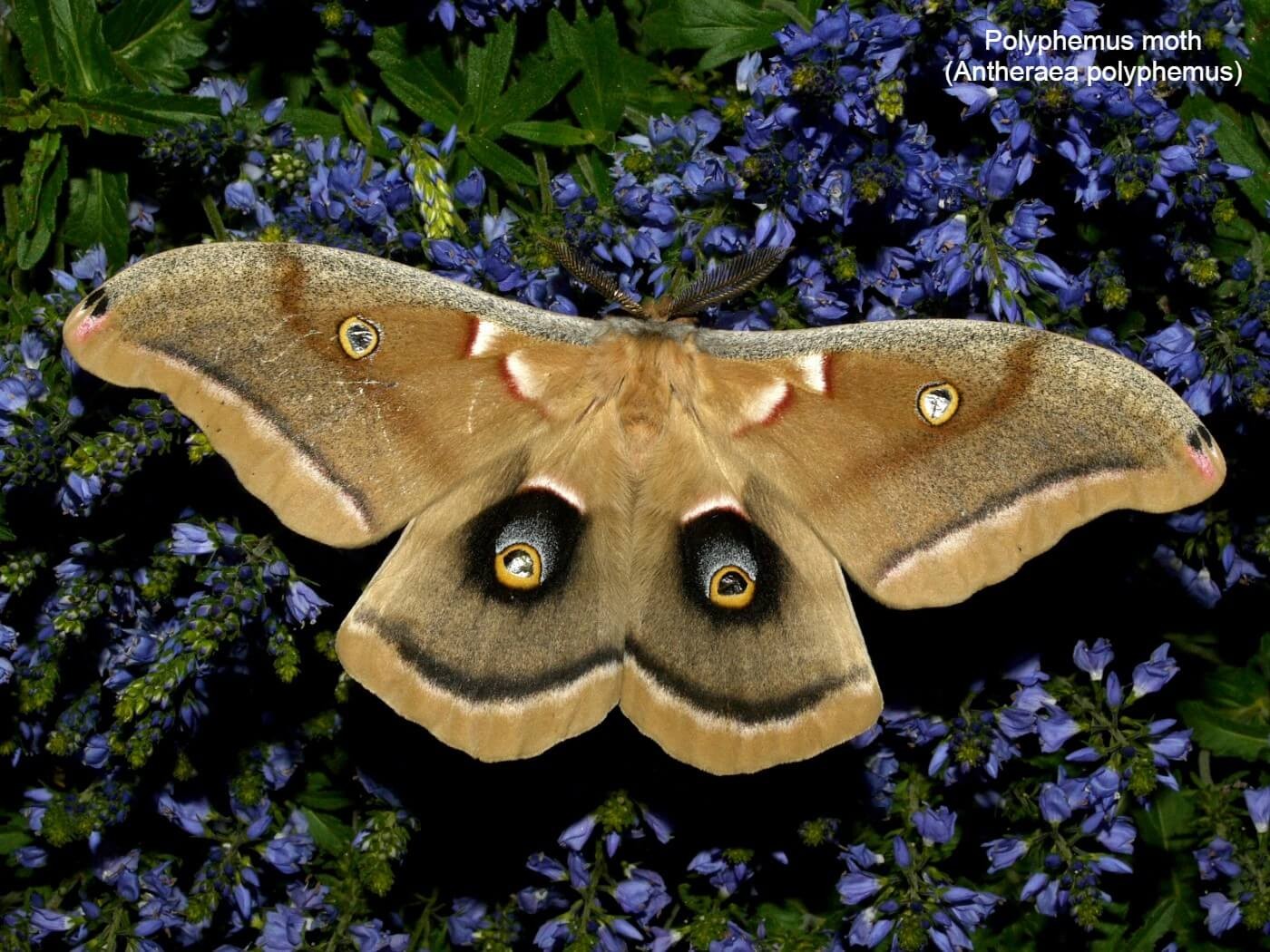
The Polyphemus moth is renowned for its striking appearance and impressive size among silk moths. Its name originates from Greek mythology’s cyclops, Polyphemus, due to the distinctive large solitary eye-spot on its hind wings. This remarkable insect boasts a unique coloration, featuring dark orange, pale brown, and black markings with scattered eyespots that add to its mesmerizing appearance.
Puss moth (Cerura vinula)
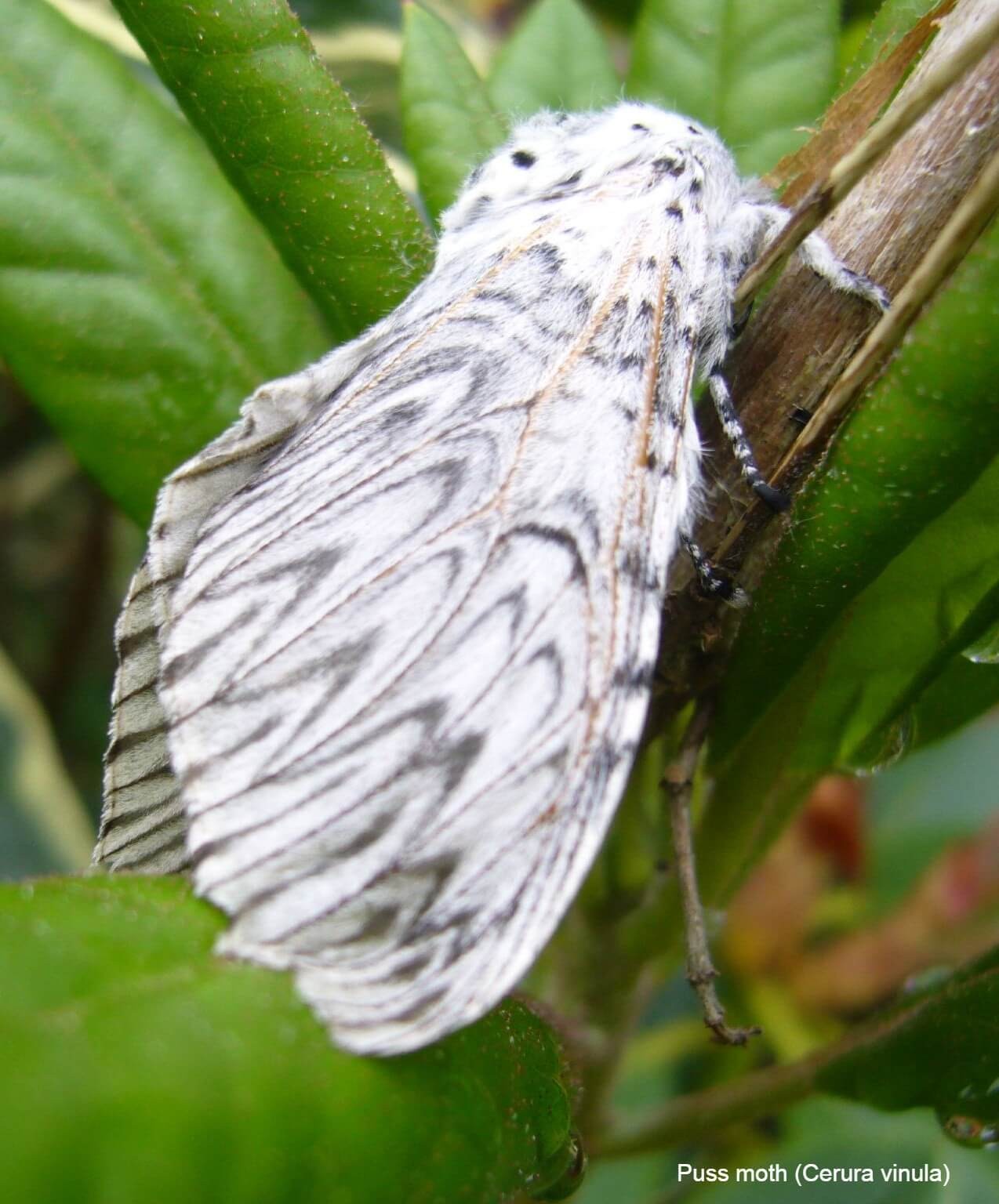
The Puss Moth’s distinctive appearance has led to its name being derived from its striking cat-like color patterns. In terms of physical characteristics, the males exhibit a more subtle hue, with pale brown coloring, whereas females display a more vibrant palette featuring shades of white, gray, and white. Interestingly, these moths are particularly drawn to willow and aspen trees for sustenance.
Regal moth (Citheronia regalis)
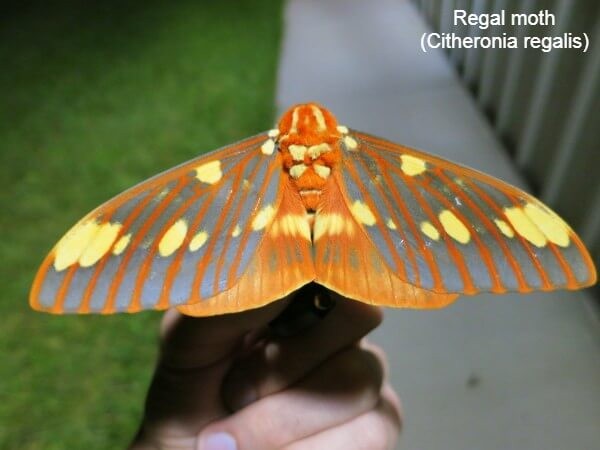
The royal walnut moth boasts a striking appearance, earning it an alternate name: the hickory horned devil. Its larva displays a unique combination of features, including a pale green body adorned with scattered black spines and prominent orange horns that number five to six. The adult’s color palette is reminiscent of vintage tones, featuring dark orange and gray-black stripes that add depth and visual interest.
Rosy maple moth (Dryocampa rubicunda)
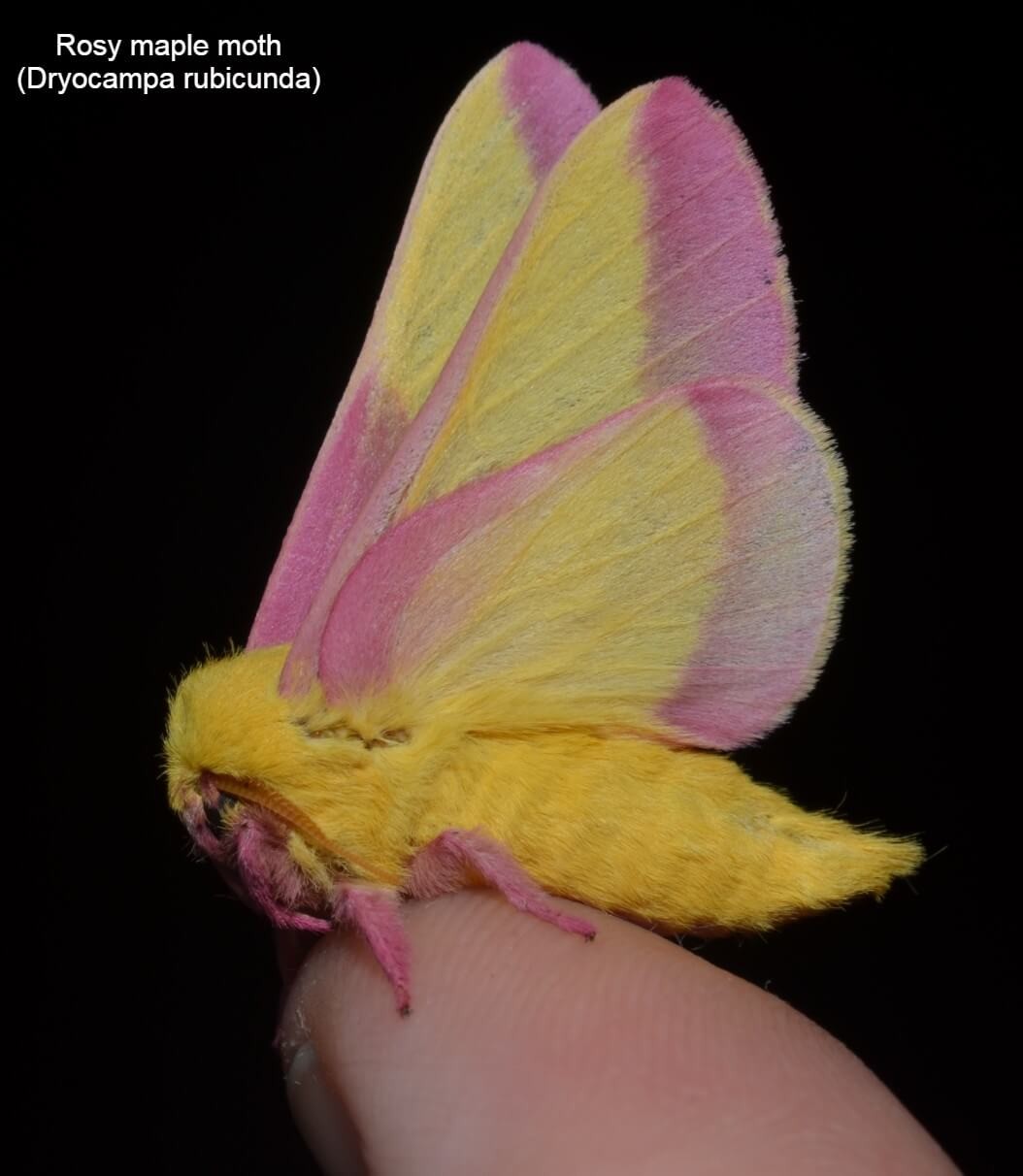
This enigmatic moth boasts an extraordinary feature – its wing color changes depending on the surrounding environment. Its woolly exterior adds to its fascinating appearance, which can range from a creamy yellow hue to a striking pink and yellow combination. Aptly named for its peculiar dietary preference, this species exclusively feeds on maple leaves.
Saturniidae moth (saturniids)
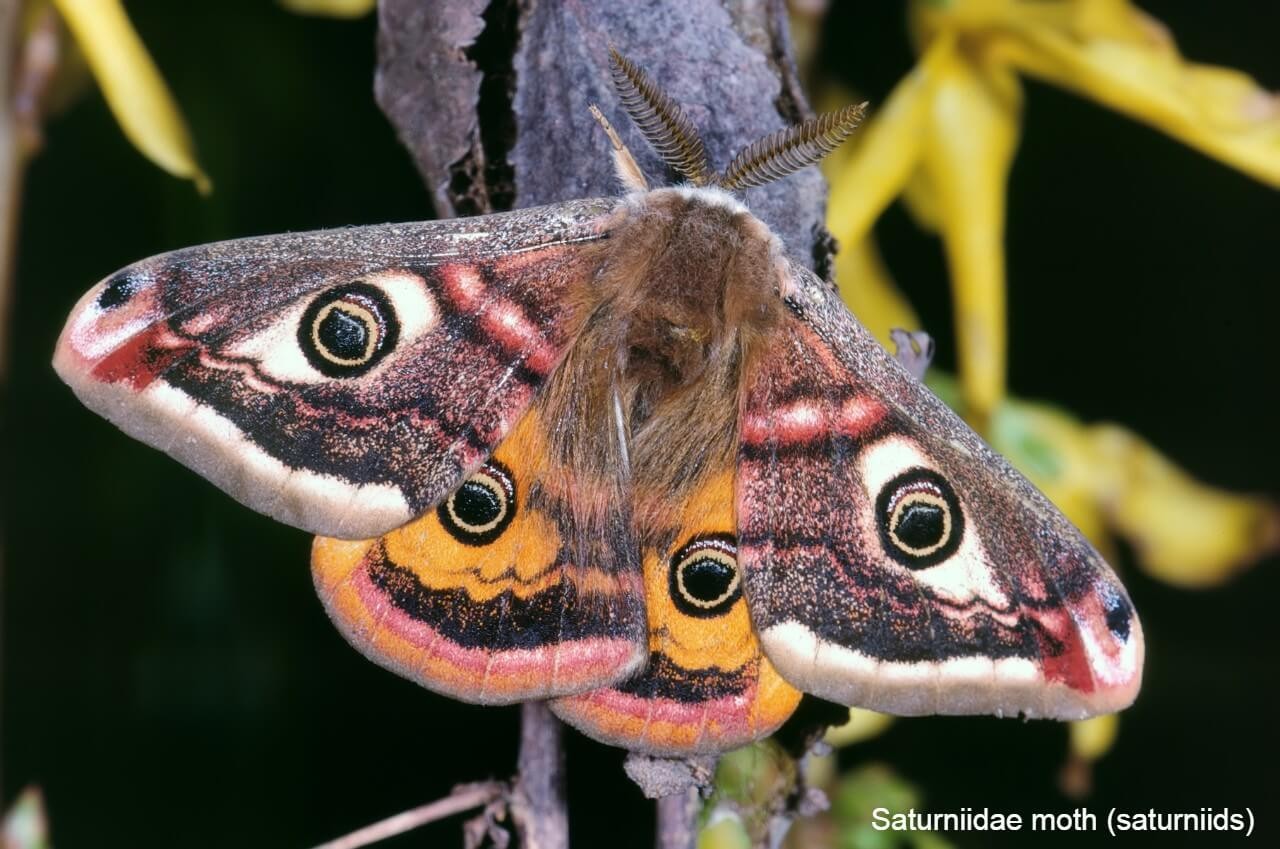
The Saturniidae family boasts an impressive title as the largest moth family, comprising a staggering 2,300 recognized species. Within this vast group, you’ll find some truly imposing insects, including the majestic giant silk moth, the regal emperor moth, and the resplendent royal moths.
Silkworm moth (Bombyx mori)
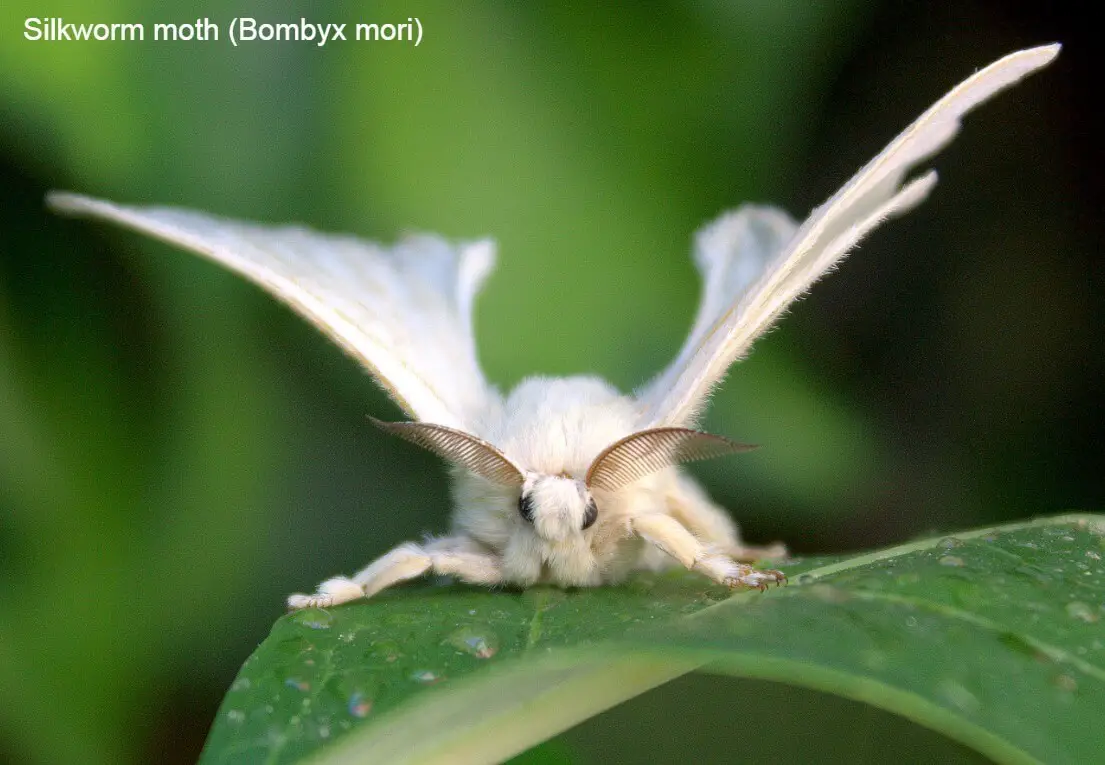
During its larval stage, this species undergoes a remarkable transformation, meticulously constructing silk cocoons that will eventually give rise to the adult moth. This process takes place primarily in China and the Middle East, where it plays a vital role in the production of silk garments and fabrics.
Small emperor moth (Saturnia pavonia)
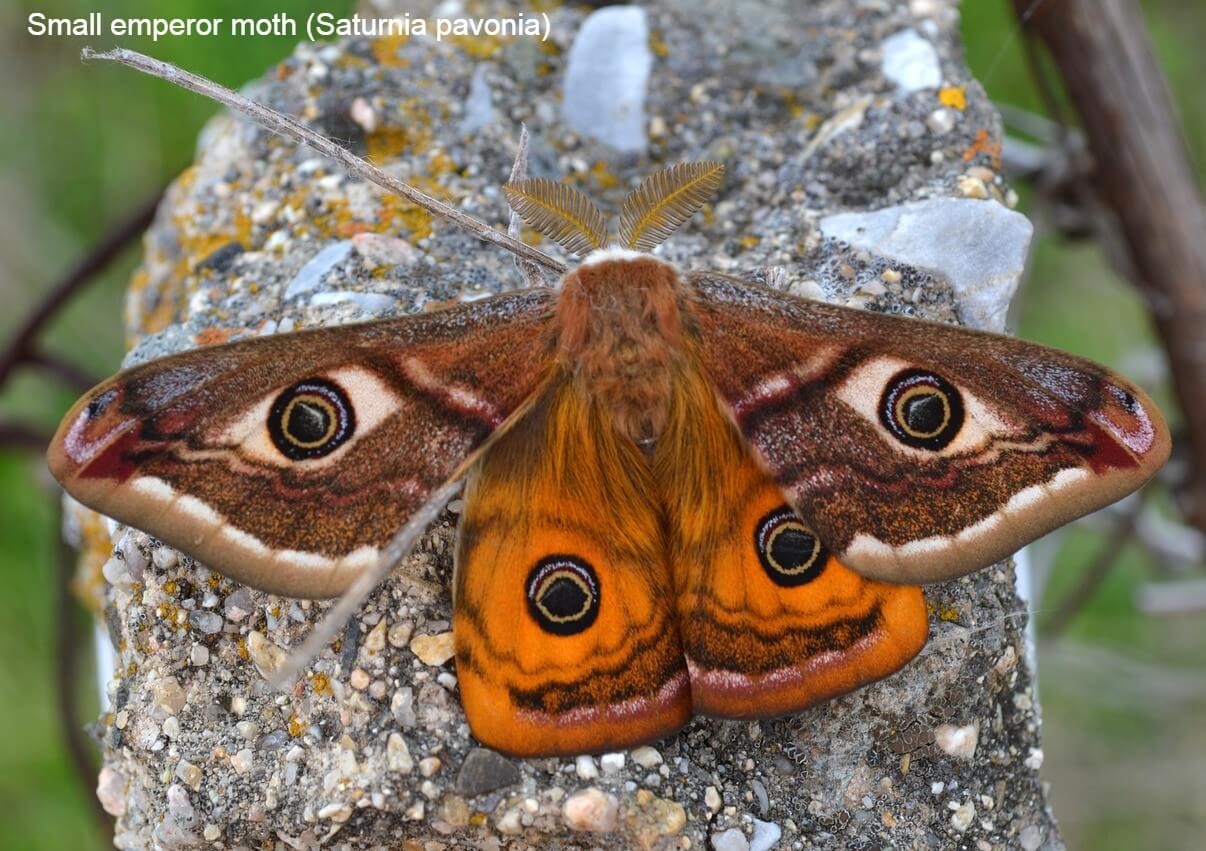
The majestic Emperor Moth boasts an unmistakable appearance, characterized by its striking black and orange wings, vibrant pink-red forewings, and distinctive black and white eyespots. A crucial aspect of their life cycle is the laying of eggs in thorny bushes, which ultimately determines their brief lifespan. In stark contrast to many other moth species, these males actively fly during the daytime, embarking on a quest for mates.
Tussock moth (Lymantriinae)

In many cases, tussock moths can become a significant vegetation problem due to their unique feeding habits. These moths tend to congregate in dense groups, leaving behind leaves with unsightly holes and silky cocoons. Florida is home to three distinct species of tussock moths, characterized by their unusual yet strikingly colored, spiny caterpillars that are as fascinating as they are formidable.
Vampire moth (Calyptra thalictri)
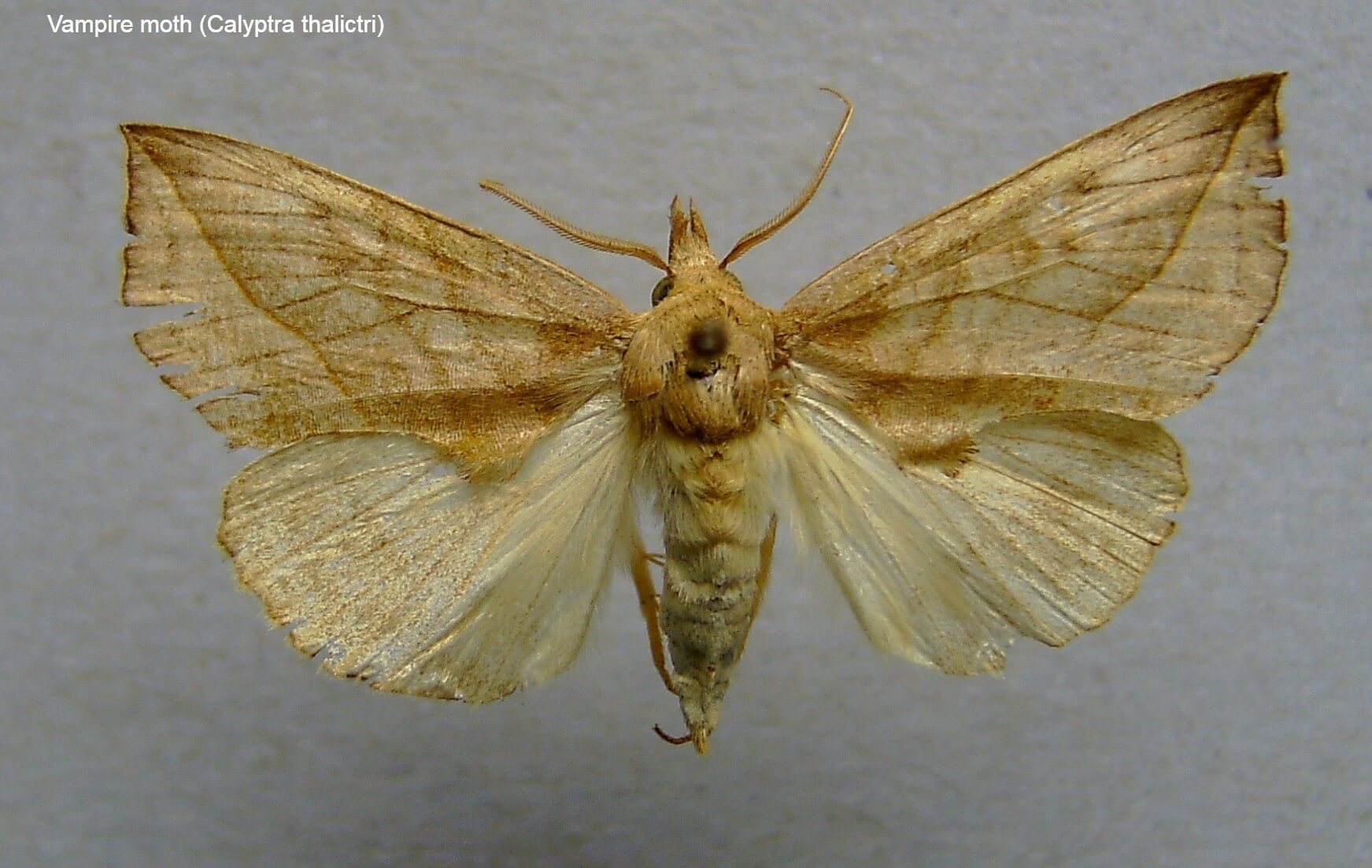
Vampire moths, a type of vertebrate bloodsucker, have earned their notorious reputation. A peculiarity worth noting is that only male vampire moths engage in this behavior. The males are capable of sustaining themselves on human blood for up to 50 minutes, leaving behind visible red sores as evidence. It’s important to emphasize that these sojourns into the human circulatory system do not pose a fatal threat to their human hosts.
Venezuelan poodle moth
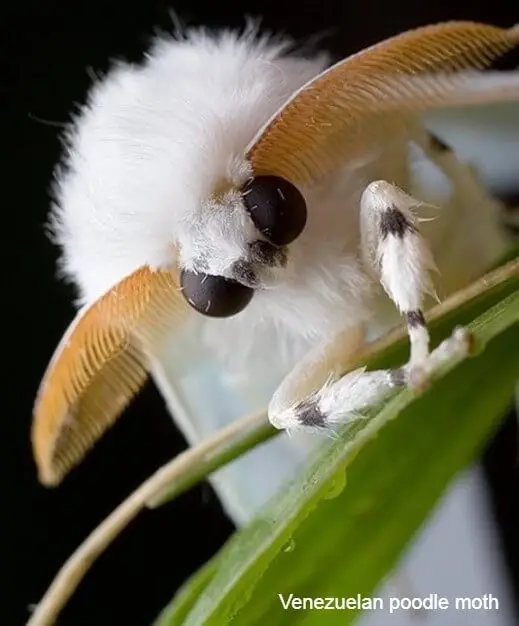
Despite being documented as recently as 2009, this species bears a striking resemblance to a Pokémon. In fact, many initially doubted its authenticity due to its uncanny appearance – imagine a massive moth with shaggy fur, sturdy wings and a body resembling a fluffy poodle. The similarity is so striking that it’s no wonder some people thought it was simply a figment of the imagination.
Yucca moth (Tegeticula yuccasella)
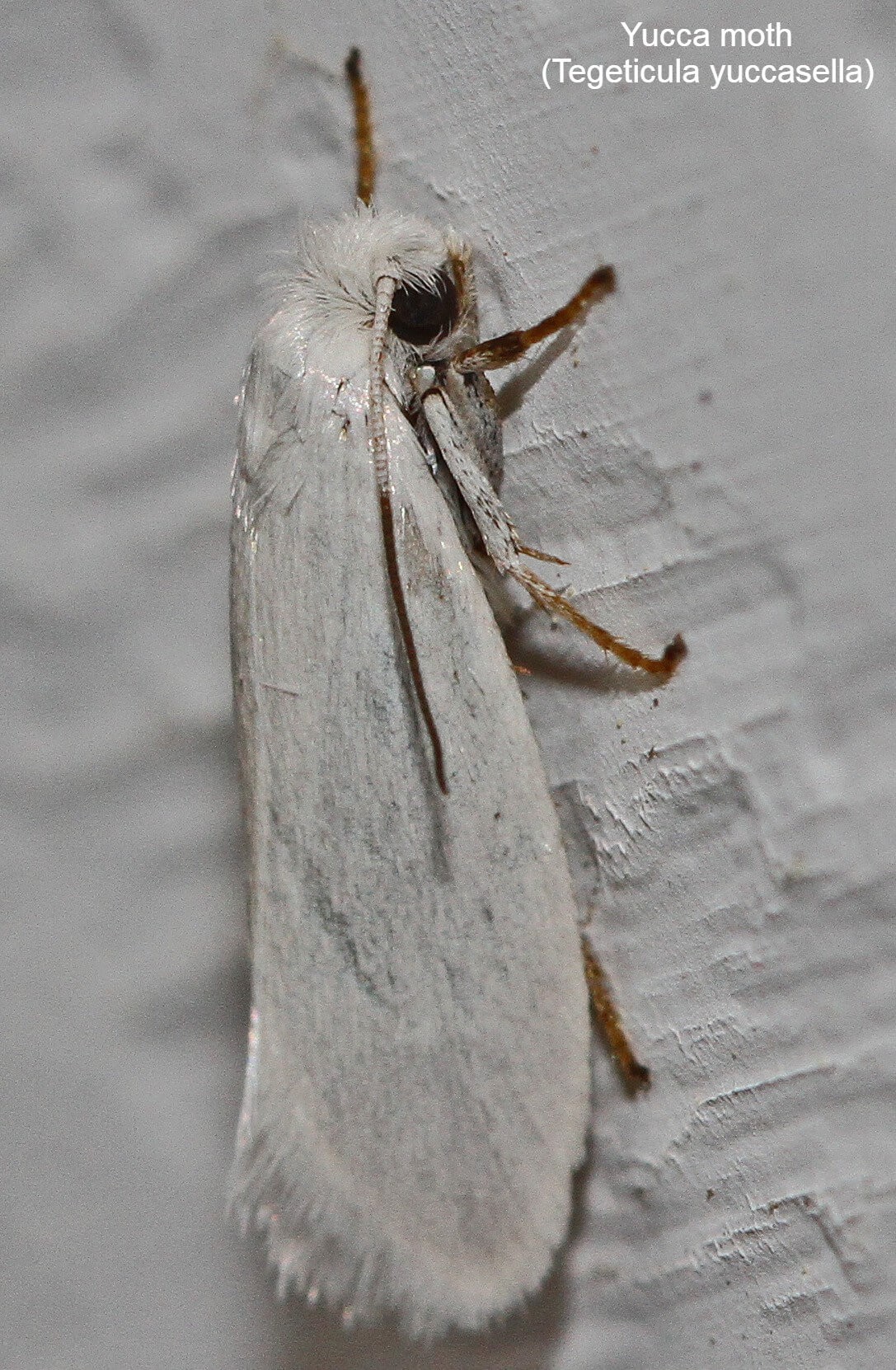
These fascinating insects have a unique characteristic – they exclusively feed on yucca plants. Their geographical range spans across south-central America, the United States of America, and southern Canada. A distinctive feature of these insects is their pale color palette, often featuring hues of cream or light brown. Additionally, they may exhibit temporary flashes of tan, adding to their visual appeal.
Why are moths bad?
Moths have a dual reputation: they’re detrimental to crops and fabrics, but also play a crucial role in wildlife conservation. On the one hand, their appetite for grains, fruits, and vegetation can decimate harvests. Additionally, their taste for clothing and fabric can result in unsightly silk balls accumulating in pantries and closets. Furthermore, when small moths accidentally find their way into our homes, they can pose a risk to our health if ingested.
However, it’s essential to remember that moths also serve as a vital food source for amphibians and other wildlife, making them an important part of the ecosystem.
How do you get a moth out of your room?
To effectively get rid of moths in your room, you’ll want to employ a multi-faceted approach. First, consider incorporating cedar into your furniture design – the aroma is naturally unappealing to these pests. In addition, maintaining a regular cleaning routine will help keep their numbers in check; be sure to dust and vacuum frequently, with a focus on areas like closets and pantries where moths tend to congregate.
If you’ve got wooly or linen items that are particularly attractive to moths, consider freezing them temporarily – this can help reduce the appeal of these materials. Finally, take advantage of natural deterrents like vinegar, herbs, or sticky traps in areas where moths might otherwise infest.
Conclusion
Moths, often misunderstood as mere pests, play a significant role in maintaining the delicate balance of ecosystems. Beyond their nocturnal nature and occasional window-sticking habits, they exhibit unique behaviors that have cultural and symbolic importance. Their affinity for light and flames, as well as their feeding habits on plants and crops, have led to significance in various traditions.
The vast array of moth species serves as a reminder of the diversity within this insect group, rivaling that of their butterfly counterparts. Despite their often-overlooked nature, moths continue to fascinate and inspire, with their life cycles, behaviors, and adaptations offering valuable insights into the natural world.
Related Posts
The effectiveness of common household solutions in eliminating bed bugs is a topic of great interest. Some people turn to hydrogen peroxide, while others rely on baby powder, boric acid, ammonia, and even Lysol. But do these DIY methods truly get the job done? We’re here to dig into the facts about each solution, exploring their efficacy, risks, and usage tips.






